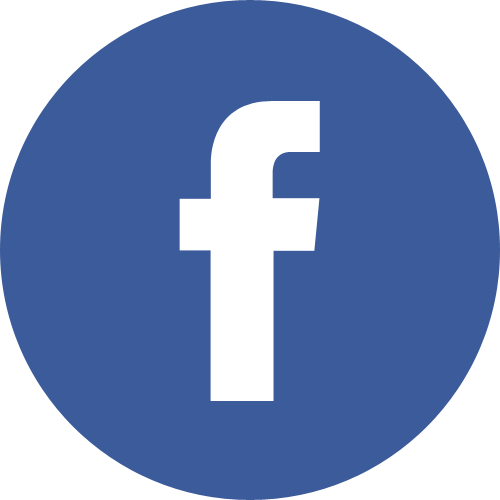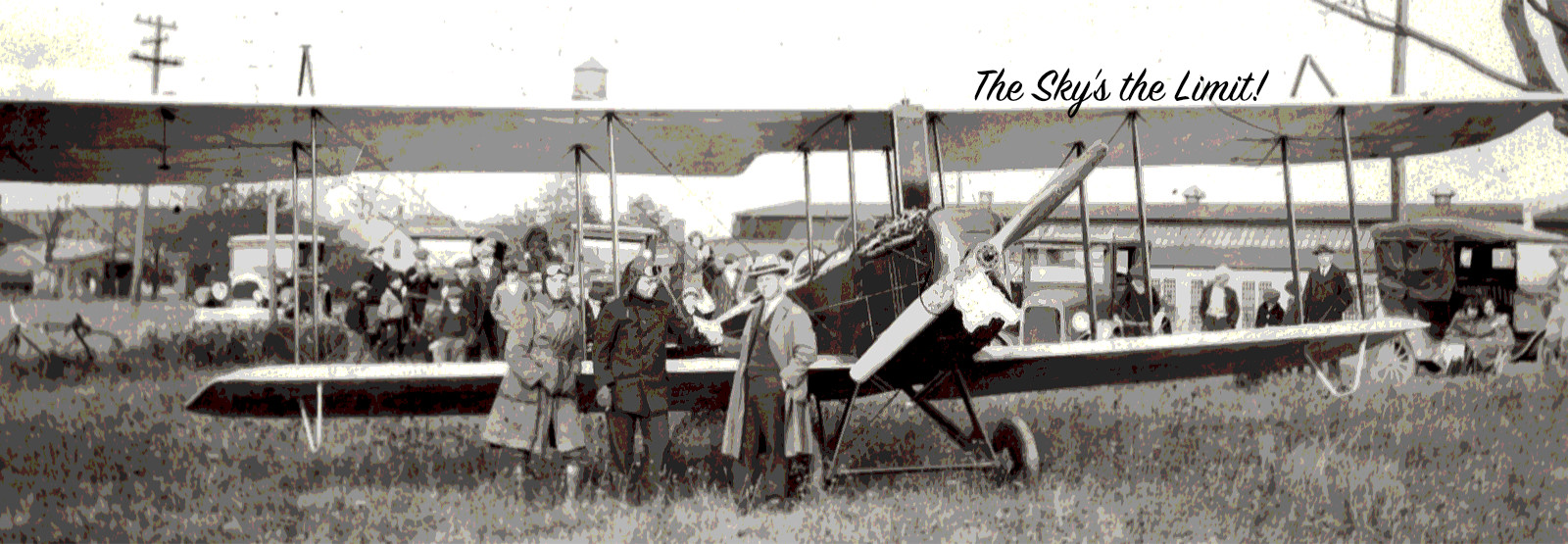

Sparta Township
Stagecoach Inn
& Highland Farm
Early settlers, Philip & Sally (Gillam) Cumings, owned 179.5 acres straddling 10 Mile Road along the south dividing line between Sparta and Alpine townships. He was born in 1799, at Stoddard, Cheshire, New Hampshire. The child was named for his father, but also his grandfather who fought at the battle of Bunker Hill. At 23, Philip wed Sally at Byron in Genesee county, New York--where they were blessed with four children: Edwin in 1823; Norman in 1825; Marien Phebe in 1827; and Nelson in 1830.
As untamed land in Kent county became available to hardy pioneers, the decision was made and their eldest son, Edwin, travelled on September 20, 1844, by railroad to Grand Rapids to purchase land for the father. The son briefly returned home on October 25th then on November 8th Edwin and Norman started back to Michigan by rail. They erected a primitive shanty on the 80 acre parcel in Section 34 of Sparta township. Philip recorded details in a diary he kept of the family's journey to their new home in the spring which noted their arrival on June 15, 1845. (For modern reference, the Cumings' land was 1/2 mile west of Ballards Corners, three miles south of Sparta on 10 Mile Road.)
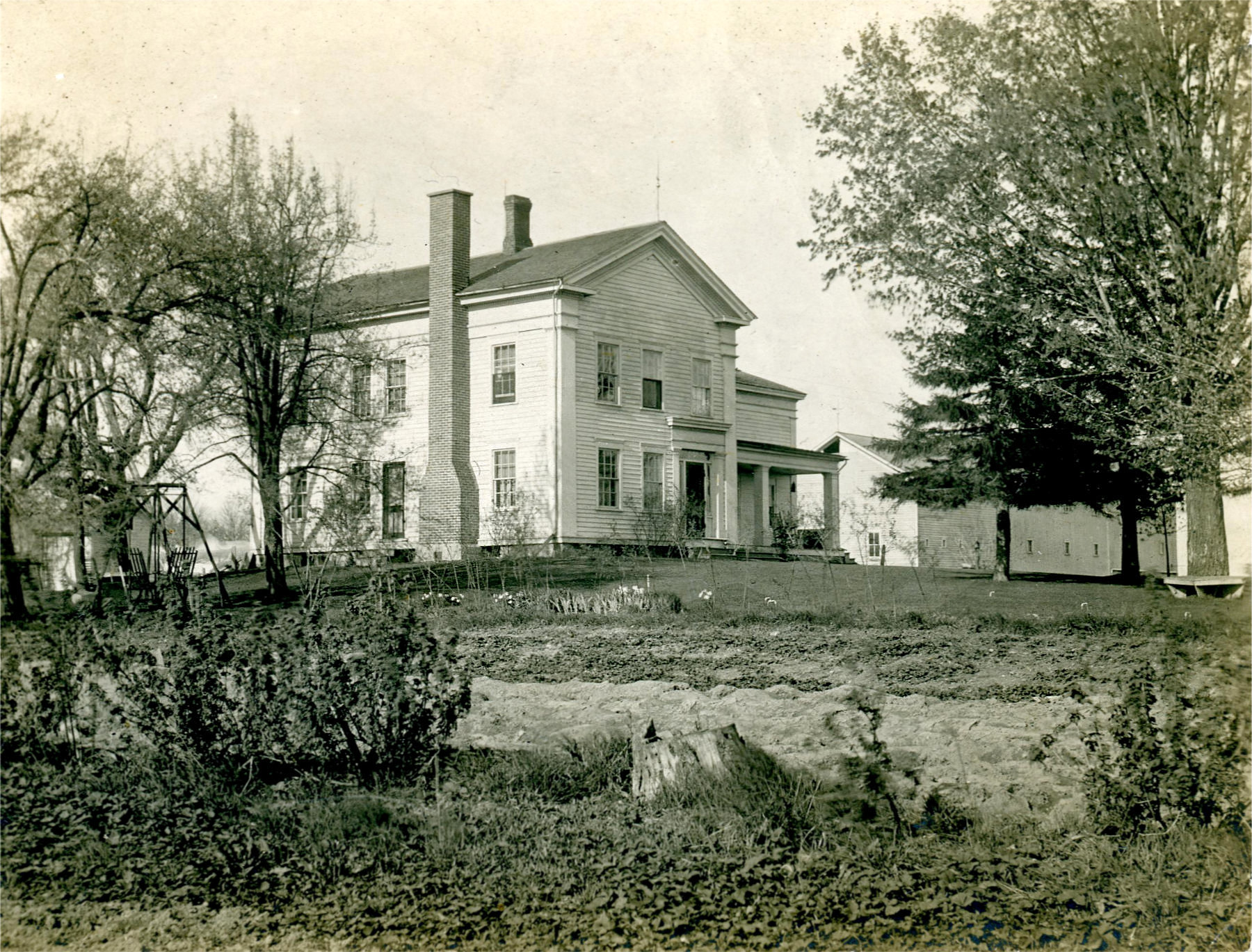
Nelson & Adelaide Cumings' grand old stagecoach inn after Jesse Field purchased the property and it became known as Highland Fruit Farm (1906-1907)--courtesy of the Karl Nickolai Collection. Featured in "The Sparta Where We Lived" coffee table book released in 2025, copies are available: Sparta Historical Friends, PO Box 163, Sparta MI 49345
Nelson Cumings
The Cumings' land was slowly cleared and improved. Philip wrote how a son measured out five acre sections for a hired man to chop and clear at the rate of five dollars per acre. "In the early days the logs that were cut would be rolled in huge piles and burned as there was no use for so many of them," stated a daughter-in-law's 1931 Grand Rapids Press obituary. A barn was raised in 1846 and when Philip died in 1850, ownership of the property passed to the youngest son, Nelson.
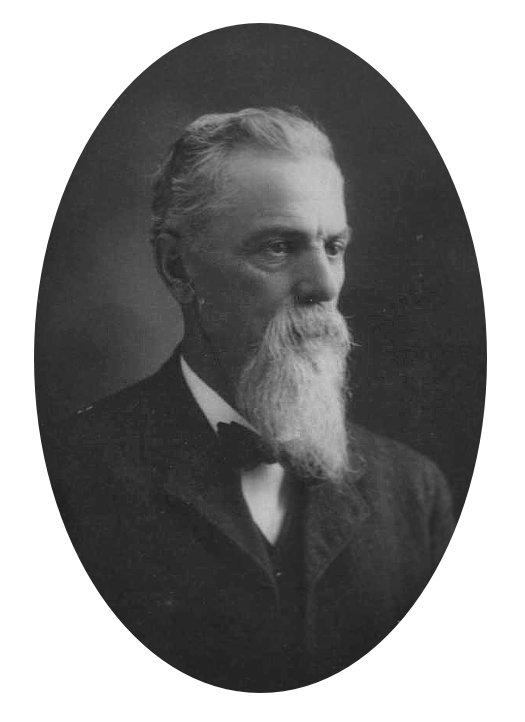
Nelson Cumings
On May 20, 1855, Nelson took Adelaide Stevenson for his wife. She had taught school at Englishville for $1.50 per week before her marriage. They were blessed with: Adelaide M. (1856-1933), Clarence Arthur (1858), Jennie May (1863), Julian G. (1865), Llewellyn (1869), and Willard Lawson (1874-1945).
After the Grand Rapids and Kalamazoo plank road was completed in 1855, weekly stage travel north of the city to Croton and back was established. Once a former Indian trail, Kent county historian Tom Carter described the stage coach route which headed north from Grand Rapids to Sparta. "Meanwhile another route went north up Alpine Road to the settlement of Alpine Station where Vinton Ave meets 7 Mile Road at the railroad tracks. From here the trail split, with one route continuing north to Englishville (10 Mile Road between Alpine and Vinton) and on to Ballards Corners and then to Sparta."
Between 1855-1863 Nelson built a large colonial structure designed to serve as a stagecoach inn attached to the existing proprietor's home his father built. Doug Crawford whose father would later purchase the property recalls a pass-thru window between the owner's large kitchen and the open sitting and dining area of the inn where guests enjoyed meals. There were four bedrooms upstairs and three rooms on the main floor where the structure was heated by a large fireplace. A sizable L-shaped barn was built behind and slightly to the west of the inn with dairy on the north portion--horses and a tool shed on the section extending east. The south side along the horse stable included an overhang of about 6' to 8' where the "privie" was located. "It was clear white pine painted grey and three pieces made up the north wall." Doug described the room, then added, "People wrote antidotes on it with pencil." One inscription from the late 1800s stated that on July 4th it snowed 4 inches! Reportedly, this portion was cut out from the board and given to the Grand Rapids Public Museum.

Adelaide (Stevenson) Cumings
Mr. Nelson was awarded a prize at the county fair in September 1859 for the "best 6 bunches" of his Isabella variety of grapes, as noted in a publication from the Michigan State Agricultural Society. These sweet grapes are a dark purple to nearly black fruit that are also known as the 'fox grape' used for eating, juice, and wine. "It would bring a cash flow in the early fall for wine sold to other farmers, churches, and served at their stagecoach stop," surmised Mr. Crawford.
Nelson and Adelaide operated their stagecoach inn until 1872 when the railroad arrived at Sparta and the coach line was discontinued. While still a young man, he died at the age of 50 in 1880.
Jesse Brown Field
Jesse Brown & Eliza A (Hubbel) Field owned a nearby farm on Fruit Ridge in Section 5 (Alpine township). At nineteen, Jesse came with his parents Jedediah & Bethana (Brown) Field and family from Waverly in Tioga county New York in 1855 and they settled at Ballards Corners and Englishville. Like many farmers of that time, winters were spent working at lumber camps in the northwoods. An issue of the Grand Rapids Eagle published on February 4, 1860, included an item:
- BROKEN LEG.--An accident, resulting in the breaking of a leg occurred a few days ago to Mr Jesse Field, of the township of Sparta, in this county. Mr Field was at the time in the lumbering woods, 60 miles above Big Rapids, and arrived home last evening, after a four days ride. Dr Ellis, of this city, was called and set the fractured limb. We learn that the prospect is favorable for his speedy recovery.
The Fields purchased the Cumings farm on April 17, 1891 for $6,500 from Adelaide, elderly widow of Nelson. Located a half-mile west of Ballards Corners, the Fields made their new home with his adult children by a first wife, Almira Jane (Fisk): Elsie Mae (1867-1965) and Ernest Worthy Field (1869-1942).
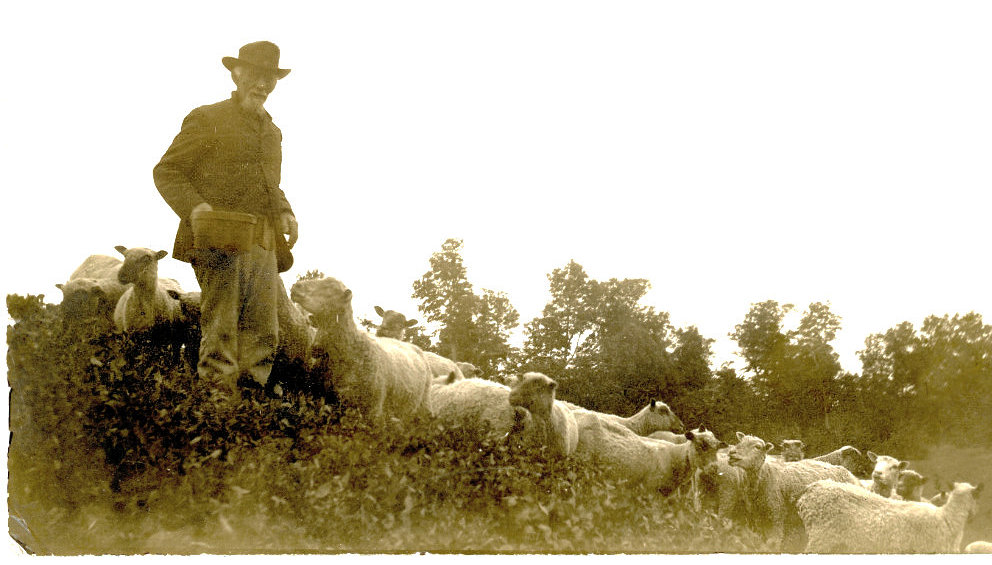
Jesse Field from a postcard mailed in August 1909 by a guest: "Dear Charlotte, This is a picture of our farmer with his flock of sheep. With love, Nannie"--courtesy of the Karl Nickolai Collection
The distinguished white manor became well known as Fields Highland Fruit Farm--not only for the peaches, apples, and grapes grown--but it would also gain prominence for their famous chicken dinners and as a summer vacation destination.
"That the peach season is now fully on needs no argument to demonstrate if one will but visit the city market any early morning this week," wrote The Grand Rapids Press for its July 26, 1899 publication. "Jesse Field brought in a most beautiful supply of clingstones of the Alexander variety yesterday from his farm one mile west of the Englishville station, and others in that vicinity, especially those whose peach trees are located on elevations, are showing first class samples." Said to have been brought back from China by Alexander the Great, peaches quickly became a favorite in Europe and Persia. The early Alexander peach is an old clingstone variety said to be very hardy with sweetly delicious fruit that are yellow with a red blush. They are difficult to find today, however, at least one source sells tree stock in the UK.
By 1906, a second home was built just beyond the barn for Ernest's family as he was involved with the farm operations. He married Edith Mae Culver in 1894 and they had two children: Joyce E. (1896-1969)--who became a librarian at Ballards--and Donald (1915-1915).
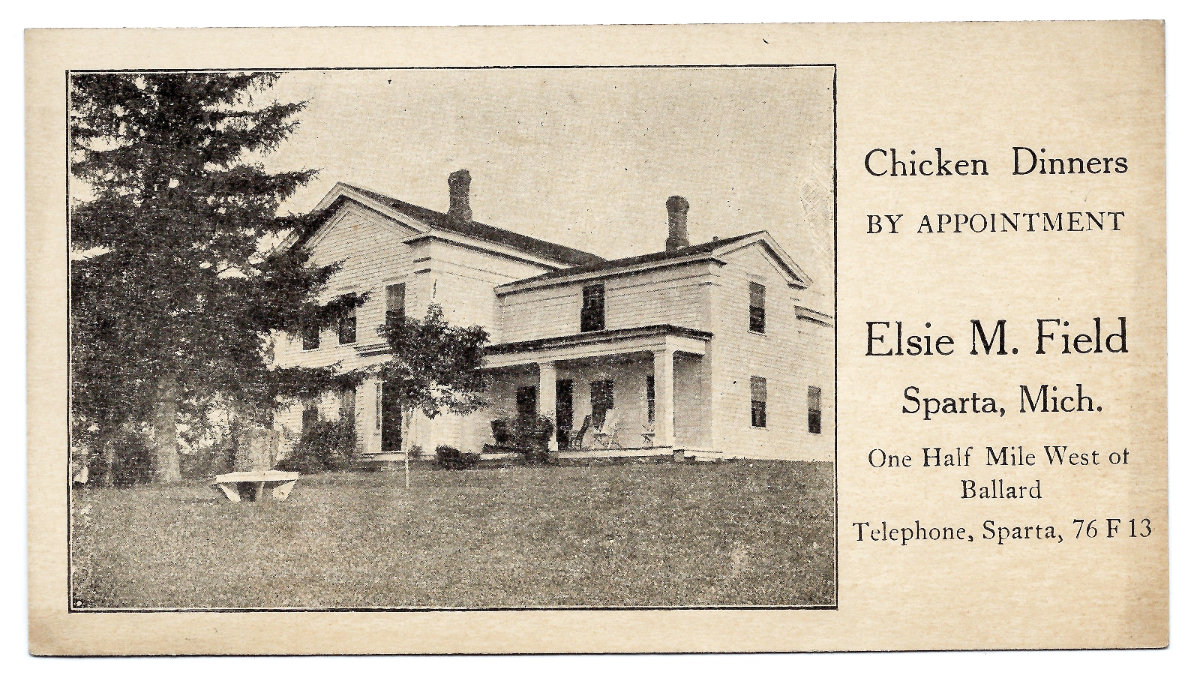
Advertisement for Miss Elsie's chicken dinners by appointment--courtesy of the Karl Nickolai Collection
Miss Elsie May Field
In 1884, at 17, Elsie began teaching school at Lisbon. She retired in 1904 from a dozen years of teaching in Grand Rapids to care for her aging father and step-mother at their Highland Fruit Farm. Mrs. Fields passed away the following year.
Elsie immersed herself in promoting the old stagecoach inn as a resort and built its reputation for delicious chicken dinners. A four-stall garage for Model-Ts was added to accommodate guest vehicles. The society column in the local paper often mentioned those vacationing at the "J B Field" farm--from New York to Oregon and points in between. Rooms were rented by the month, on a weekly basis, or overnight. Historic postcards mailed by guests included favorable descriptions of the southern view, the establishment itself, cleanliness, their hosts, and food.
The 1910 Federal census recorded the widowed father and daughter along with a hired man, Lawson Church, at the property. Jesse became ill, was hospitalized, and passed away in 1912. The daughter continued the business. An advertisement in The Grand Rapids Press read: "WANTED--Summer boarders at the Highland fruit farm. Address or phone Elsie Field, Sparta, Mich." which ran during the summer of 1916.
In 1917, Miss Elsie wrote the Women's Column for The Sentinel-Leader where she covered timely topics of the suffrage movement, how women could assist in the war effort, and "Equal Pay For Equal Work".
-
MAN ARRESTED FOR CAR THEFT THROUGH CHICAGO MAIL ORDER
Grand Rapids Herald (29 Mar 1930)
Doing business with a Chicago mail order house cost Mitchell, 20, his liberty. Mitchell was arrested Thursday in Ontonagon county, in the upper peninsula, on a charge of stealing an automobile owned by Miss Elsie Field of Sparta.
According to Sheriff Patterson, Mitchell was for three weeks a farm hand at the Field home until on March 10 his admiration for Miss Field's car led him to enter the garage in the middle of the night and drive the machine away.
Casting about for clues, Patterson learned from Miss Field that Mitchell had ordered some clothing from a mail order company, so a telegram was sent asking whether the goods had been delivered. The company responded that Mitchell had appeared at its Chicago offices to get his money back, but they had refused his request, and that he then ordered the goods sent to Ontonagon, where he said he would call for them March 27.
Patterson notified the sheriff at Ontonagon, who arrested Mitchell and seized Miss Field's car. Mitchell is to be returned here Monday.
Miss Elsie continued to offer her chicken dinners by appointment into the late 1930s, but less frequently. After all, she was in her seventies and ready to retire. Eventually, she sold the property about a decade later to Clarence & Julia Ann (Saur) Crawford, who were neighbors up the road on Peach Ridge. However, by then most of the buildings had fallen into a state of disrepair.
Clarence Crawford
The Crawfords lived in what was Ernest's house. "Seventy years ago in the 1950s, the old apple orchard south of the house was removed with a bulldozer." Doug remarked, "They were the biggest apple trees I'd ever seen. We counted more than 100 rings." The Crawfords replanted orchards to raise apples and cherries.
Doug and his brothers explored and played in the former stagecoach stop as teenaged boys. "The wood was prime clear white pine. Some boards were 1-1/2' wide," Doug marveled at the floorboards as he described the lumber used in the construction of the old inn and barn. "The (exterior) corners were single boards 2' wide by 20' long and 1-1/2" thick." Around 1960, the buildings were sold for lumber reclamation and torn down.
"To the west of the apple orchard was a vineyard of between 6 and 8 acres in size," recalled Doug as he commented on the plot of century-old vines. "It was the only known vineyard of that size still there and only (Ernest's daughter) Joyce could trim them each year."
Later, the Crawford house at 2106 10 Mile Road became the residence of a cousin, John Reister.
Little evidence remains of the stagecoach era of bygone days. However, as a pilot in the 1990s, Doug saw and described visible remnants from the old stage routes where it ran through wooded areas as evidenced by strips of younger trees. A reminder that remnants of the past can be found--if one knows where to look.
The Rise & Fall of Lisbon
Before the little berg of Lisbon became the ghost town it is today, it once rivaled Sparta and even might have had the potential to eclipse it. After the first settlers arrived in 1845 to clear woods and establish their homes, surveyors and road builders soon followed as they worked to connect Grand Rapids with Newaygo by a state road. This planted the seed for a bright future.
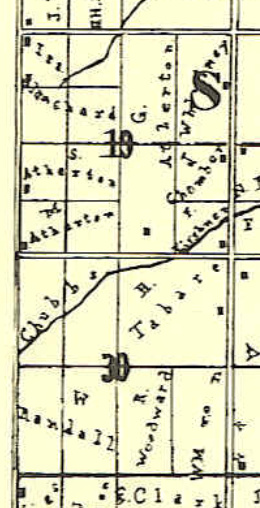
1853 Sparta township plat map showing the eastern portion of Lisbon in Kent county with homes on the properties of the Atherton brothers.
A post office was established on December 30, 1847, and "John Pintler became Postmaster, the office being called Pintler's Corners, the name by which the locality was known for many years," per the 1893 Portrait & Biographical Record of Muskegon & Ottawa Counties, Michigan. At regular intervals, the federal government solicited proposals for carrying the mail. Specifics were published in newspapers across the state for contracts effective July 1, 1854 through June 30, 1858. The notices appeared in January through April 30th of 1854 which was when decisions would be made. One of the hundreds of available routes began at "Grand Rapids, by Indian Creek, Pleasant, Pintler's Corners, Casnovia and Newaygo to Croton, 60 miles and back, once a week. Leave Grand Rapids Thursday at 6 am; Arrive at Croton next day by 10 am; Leave Croton Friday at 1 pm; Arrive at Grand Rapids next day by 5 pm. Proposals for twice a week service to Newaygo are invited." Another route advertised brought the mail to "Sparta Centre from Pintler's Corners, 5 miles and back, once a week." To start, the mail was transported entirely by pony express until the first stage coach from the Grand Rapids & Big Rapids Coach Line came through in 1855 and brought the mail as well as passengers. Lisbon bustled with economic activity. Later a relay station added at Pintler's Corners allowed passengers to switch from the north-south coaches and travel west to Muskegon.
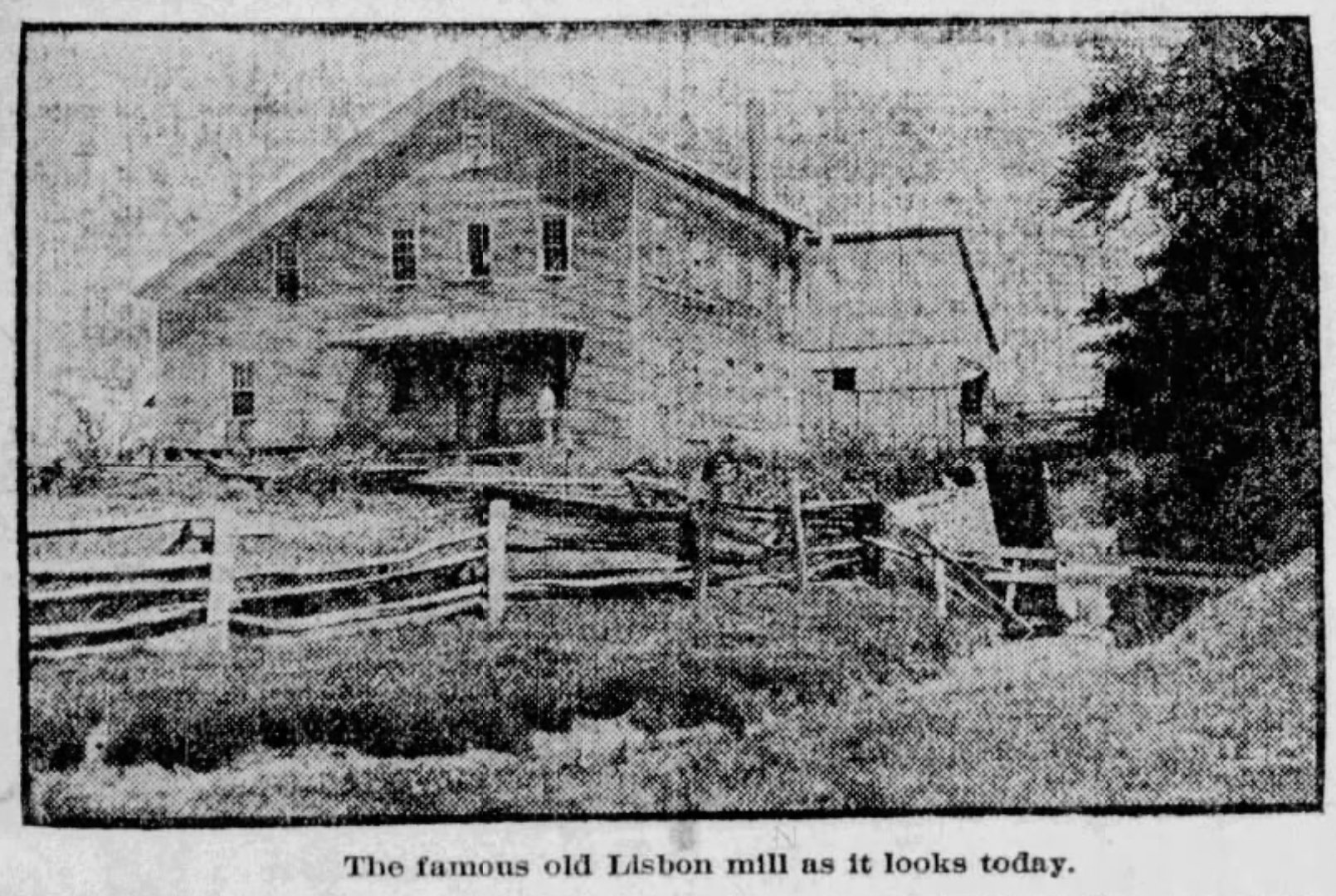
Benton Thurston built the large flouring mill in 1860. Mike Miller's steam powered grist mill was later owned by the Bird Brothers, Washington Heath, Emanuel King & his son, George Conrad King--photo from The Grand Rapids Press (21 Sep 1907)
Perched along the western edge of Sparta township in the rolling hills of the bountiful Ridge, Pintler's Corners straddled the Kent and Ottawa county line at what we now know as 12 Mile Road and Kenowa Avenue. John Pintler's home was built on the Ottawa county (west) side of the road. On October 21, 1859, the name was changed to Lisbon by the post office when Miner Atherton received an appointment as Postmaster and it moved to the Kent county (east) side of the road. Miner had established a general store on the northeast side of the four corners earlier, before 1855--one of the first to choose the Kent county side of the road--along with his younger brother Sylvanus Atherton. Up until then, most of the homes and businesses had been built on the west side of the road. By 1863 a saw mill and several additional homes joined the Athertons in Sparta township. It wasn't until March 16 of 1869 when the municipality gained official status by resolution of the Michigan Senate: "To incorporate the village of Lisbon, in Kent and Ottawa counties."
Prosperity came thanks to it's location along a well-traveled stage coach route between Grand Rapids and Newaygo, but faded away when the railroad chose Sparta, instead. The pastoral rolling hills which lent a charming beauty to the area turned out to be its downfall. The railroad decided to take the easier route: more level and cheaper to build.
Stunned to see their village's success derailed, most businesses and the 350 people who called it home left--especially the young. By 1903, the population had decreased to 156 people and in 1940, just 51 were left. Buildings, homes, and farms were abandoned, deteriorated, and were slowly reclaimed by nature. Some of the lucky homes were moved to other places--like Sparta. Determined folks stayed--after all, Lisbon was their home.
Lisbon, When Trinity Church Was Formed In 1865
published in The Sentinel-Leader (30 Aug 1951)
The village of Lisbon, now in the stages of retirement, was a prosperous town when Trinity Congregation was formed in 1865.
Settlers for miles around came to the Koon Drug Store to collect their mail. The mail was brought to Lisbon by stage coach which then ran from Grand Rapids to Newaygo. Lisbon was one of the places where the four horses pulling the stage were changed.
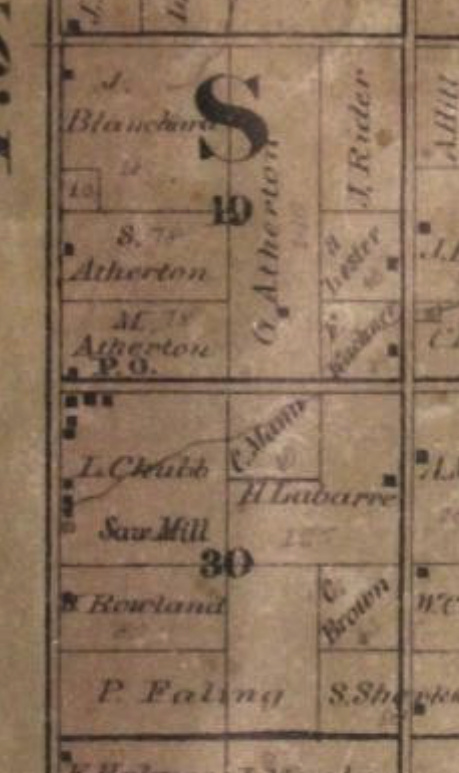
1863 Sparta township plat map showing the eastern portion of Lisbon in Kent county--courtesy of the Karl Nickolai Collection
While in Lisbon the people could go to the grist mill, started by Mike Miller, a member of Trinity. Here their wheat was ground into flour. The original grinding stones used in this mill may now be seen on the front lawn of the John Lachmann farm or at the home of Henry Schaefer. With the grist mill, Mr. Koenig, who later purchased it, also ran a saw mill and cider mill. Cider that was not taken back home by the farmers was made into apple cider jelly. All of these "King" mills were powered by steam.
Four well-stocked stores allowed the settlers to trade any surplus foods they had raised for provisions they could not raise. Shoes and boots were ordered from one of the two shoe-maker shops. These shops also made harnesses for the farm horses. The wagon maker's business was turning so fast that several helpers were needed to supply the demand. A hardware store, with a complete line of farm equipment, also did a great service to the early settlers.
The Koon Drug store carried a large supply of drugs and medicines and was of great help to the two Koon brothers, the only medical doctors for miles around. A barbershop and a saloon were also stopping places for many a hard-working farmer.
Lisbon had a right to be proud of its two churches. For a while many efforts were made to have Trinity Lutheran establish itself there too. It could also boast of a fine school, where children could continue through the tenth grade.
Lisbon seemed to prosper. But in 1873 the stage coach run was discontinued because a railroad now ran from Grand Rapids north through Sparta, and mail was carried by train. The mail was still brought from Sparta to Lisbon for distribution.
More land was cleared of trees and soon the King saw mill was torn down. Some businesses and buildings were moved to Gooding, where the railroad from the west seemed to promise an endless supply of logs for a saw mill. Other buildings were moved to Sparta.
As the founding fathers of Lisbon died or moved away, the entire village seemed to fold its tents and fade away too. Trinity congregation, on the other hand, has prospered and grown under God's help. It began with 14 families in 1865 and now has more than 250 families as members of the church.
Where did Lisbon get its name? A column "What's in a Name?--How Michigan Areas Were Christened" by Ted Foster in the Lansing State Journal from 1 Mar 1954 addressed the question. "The name of Lisbon was borrowed from Lisbon, NY, which in turn borrowed the name from Lisbon, Portugal." Why did the US Postal Service choose that name? That is still a mystery.
A. J. Boorom's Oil Fever
At the close of the 1870s crude oil production in the United States neared 20 million barrels a year used primarily as kerosene, for lubrication, and in oil lamps to replace whale oil. Once Ford and other manufacturers made automobiles within the grasp of average citizens, the volume of crude production increased by six-fold to 126.5 million barrels in 1906. With the rising popularity of the automobile, interest in oil discovery ignited across the country... including Kent county. Fueled by the publication of state geological maps which showed potential reserves of oil and coal in Kent county, speculators swarmed in.
Around 1888, an oil well was sunk in the Godfrey Addition on the south end of Grand Rapids. "...Ten thousand dollars in cash was sunk along with it. The prospectors took the state geological maps and argued that if they went down 2,700 feet they would strike petroleum. Local businessmen became interested. A stock company was formed and the diggers went at it. They sunk a hole in the earth eight inches in diameter and proceeded with it for 2,200 feet before trouble overtook them. They went through all sorts of geological formations, found wells of salt water, etc., but passed them by in the earnest search for oil. At one time they landed a streak of natural gas and for days and nights had a flame three feet high spouting away at the mouth of the piping."
"The Godfreys, the Hesses, the Powers, the Rathbuns and a lot of others were interested in that oil well. One morning Mr. Hess was congratulating himself in the presence of a number of friends upon how much his stock in the oil company would be worth. He was sorry he did not have more. Then suddenly the oil well sunk out of sight. The tool broke loose and dropped. The investors spent a lot of money trying to get them out. They got a cable attached finally and thought they were going to raise the outfit for sure. The cable broke and they never found it again. Some were willing to start a new well, but a majority tired of the thing and Grand Rapids' oil boom soon became a memory," as the tale was told in HUNT FOR A MINE--Grand Rapids May Be Ballasted With Coal in The Grand Rapids Press on October 13, 1898. A Mr. William Chappell, president of the Saginaw Coal Company, requested the data and borings from the earlier oil well drilling to assist in the determination as to the feasibility of starting a coal mine under the city.
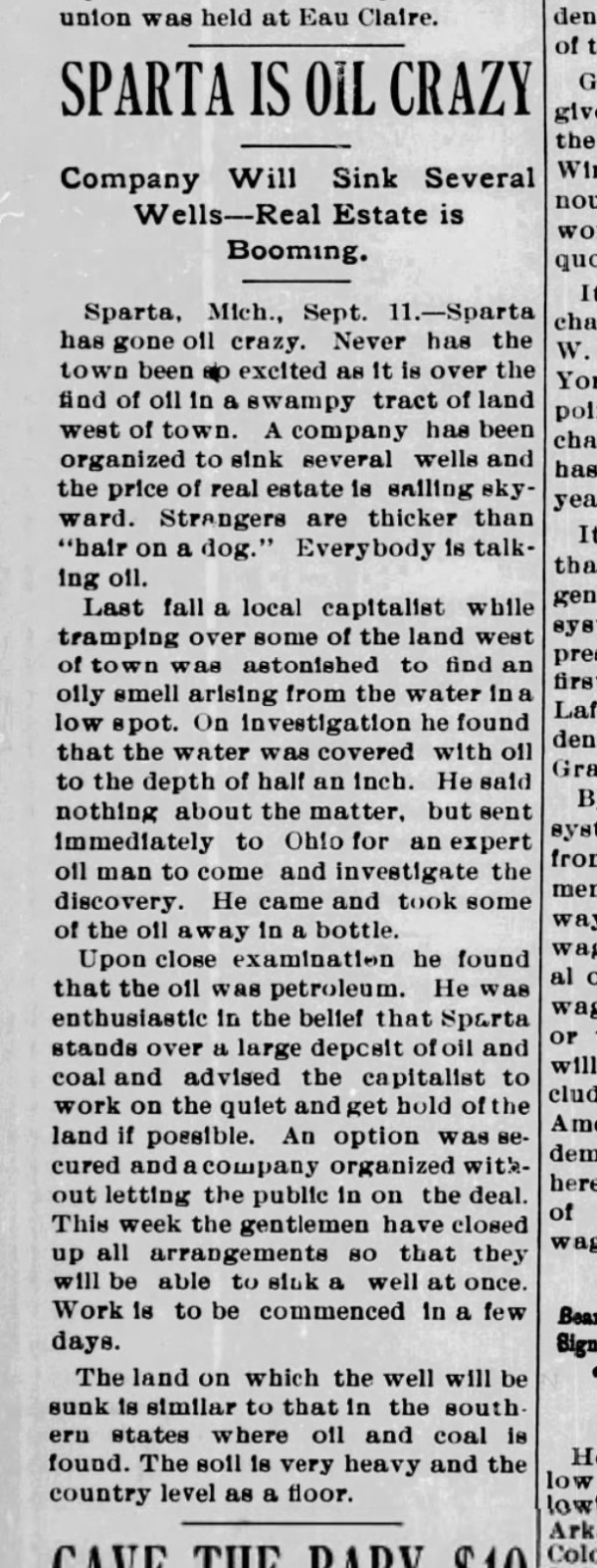
SPARTA IS OIL CRAZY--Company Will Sink Several Wells--Real Estate is Booming.--"Strangers are thicker than "hair on a dog". Everybody is talking oil."--The Niles Daily Star (11 Sep 1902)
The Grand Rapids Press September 9, 1902, headline FOR OIL AND COAL was impossible to miss. Sub-titles enticed readers: Company Formed to Bore In Northern Kent.--Expert Talks of the Wonderful Prospects Under the Fields Just West of Sparta. The report described details of its whereabouts: "The location of the proposed oil well is west of town on a tract of land that resembles the oil fields of the Southern states. The soil is of a heavy clay and for a mile square is as level as a floor. The signs of oil were discovered by a local capitalist while out walking across the fields half a mile west of town. While near a low spot he noticed the odor of oil in the air. Upon investigation he discovered oil on top of the water in several mud holes. It was half an inch thick."
Without telling a soul of his find--even his friends, he brought in an oil expert, who confirmed it was indeed petroleum and "...advised the man who made the discovery that he believes both oil and coal will be found in abundance there. He said he had never before seen such a good outlook." The land was purchased. A company was organized in secret and with the public announcement plans were divulged that they were in the process of securing the necessary machinery. "The men interested have ample capital and probably several wells will be sunk."
News spread like wildfire across the state as the The Kalamazoo Gazette was one of many to print a news flash "OIL CRAZE AT SPARTA--Everybody is Dreaming They Will Soon Be Millionaires." and stated "The oil craze has struck Sparta a hard rap and the people are all wild over the outlook for gushers..." The Niles Daily Star chimed in on the eleventh with SPARTA IS OIL CRAZY--Company will Sink Several Wells-Real Estate is Booming.
- STRUCK BY THE OIL FEVER--Michigan Community Sees Oleaginous Riches Coming Its Way.
Sparta, Mich., Sept. 12.--The oil fever has struck Sparta and the country west of here is expected to soon rival Spindle Top heights in Texas. Last fall a local capitalist came to the conclusion that oil existed under the town and sent to Ohio for an expert oil man to come and investigate the situation. He came, skimmed some of the oil off the water in a mud hole, and after a critical examination, pronounced it the genuine article and predicted great things for the men who would bore for the fluid.
The capitalist went quietly to work and organized a company. All the arrangements are now made and a 3,000-foot hole is to be sunk at once. The land on which the find was made is very level and resembles the Ohio oil fields. The soil is a heavy clay. In several mud holes where water stands, oil rises to the top to the depth of half an inch. Everybody here is talking oil and the price of real estate is soaring skyward. The town is crowded with strangers as never before.--The Herald-Paladium, Benton Harbor (12 Sep 1902)
Just the fact a newspaper could use the word "Oleaginous" speaks to the intelligence of its audience.
The National Democrat published on the eighteenth at Cassopolis, Michigan, revealed in OIL BOOM IS ON IN SPARTA--Property Is Advancing in Price and Buildings Are Rented. "A company to be known as the Sparta Oil company has been formed to bore for oil and coal on land west of town, about eighty rods." This bit of information helps to place the oil well location as 80 rods equals 110 yards. In 1902, the western border of the village was along Pleasant and Main (now State) Streets. However, another report stated the location was a half mile west of Sparta.
The existence of the Sparta Oil company was brief. Other than the initial announcement of its formation, nothing further can be located. Early news reports seemed tight-lipped as to the identity of the man who discovered the oil. However, a name slipped out in an item published on the twenty-fourth:
- WAS BURIED DEEPLY
Pine Log Found One Hundred and Forty Feet Underground Near Sparta.
Sparta, Mich., Sept. 24.--All the learned men in the northern part of the county are puzzling their brains over a singular find that was made on the farm of Andrew J. Boorom, west of town, a few days ago. Workmen are sinking a well at this place, and when down in the earth to a depth of 140 feet they struck a pine log. No excavations have ever been made at that point in past years that anybody knows of and people are wondering how the log came there. The only solution to the problem that has been offered is that at some time a heavy flood changed the lay of the land, washing in new dirt to a depth of many feet.--The Grand Rapids Press (24 Sep 1902)

Andrew J. Boorom--courtesy of the Julia Baehre Rothwell Collection
Andrew J. Boorom
Henry & Lois (Tompkins) Boorom lived at Bloom in Seneca county, Ohio in 1830 and welcommed their son, Andrew, on May 7, 1833. The father died in 1846. Lois and the children--Anthony, Andrew, Louis, and Martha--moved nearby to a place called 'Reed' to live closer to family. In 1850, Anthony was employed as a brick mason and Andrew was a laborer in the masonry and plaster trade. Shortly thereafter, the Boorom and Finch families relocated to Sparta township to become farmers. The Boorom brothers, Anthony and Andrew, married Sally and Lucinda, respectively, daughters of Albert & Rachel (Thompson) Finch, between 1854-1856. (There was no apparent close relationship between this Finch family and the meat market family of Sparta.)
"Not having money to purchase land to his liking," A.J. Boorom's biography from Chapman's History of Grand Rapids (1881) stated, "he contracted for fifty acres in timber on section 6 of Sparta township, the deed to be surrendered on payment, or the money already paid forfeited. He was dependent on his labor to raise the money, and soon after was taken sick, making his future prospects dismal. Mr. John Symes, a friend, offered him the money to secure him the land, but he had no means to secure the note. Unsought, Mr. L. Murray, another friend, offered his endorsement; and when he recovered he went to work on his land in good courage, paid for it and bought 54 acres more, making a fine farm, and has a new and commodious home with suitable outbuildings."
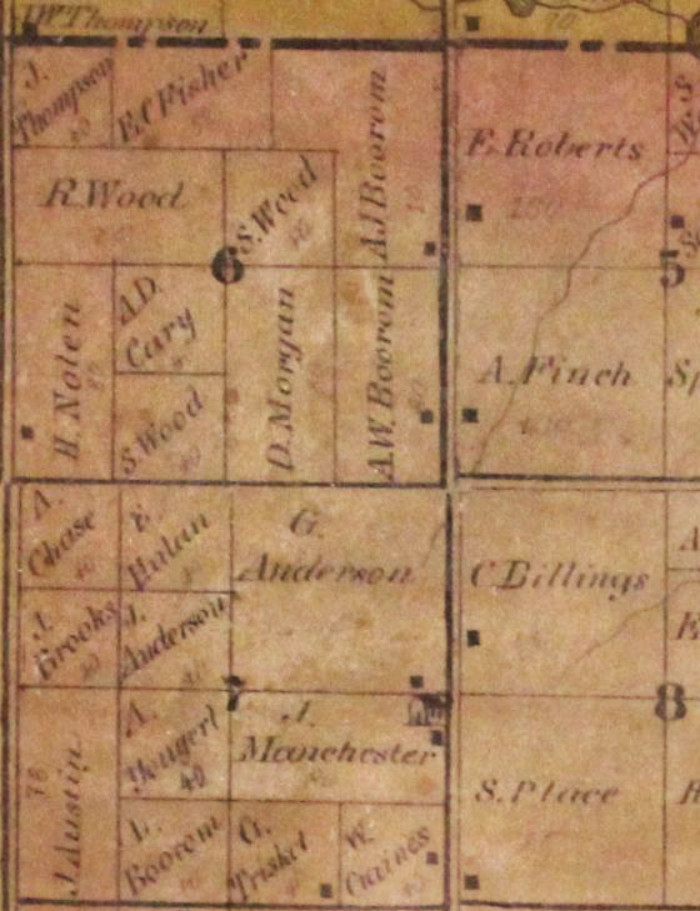
Boorom and Finch properties per 1863 Sparta Township map--courtesy of the Karl Nickolai Collection
Andrew's farm was situated on 17 Mile Road and the west side of Fruit Ridge, which was then known as Walker Road, per the 1863 Sparta township map. Anthony's farm adjoined his brother's with frontage down to 16 Mile Road. Their father-in-law, Albert Finch's 160 acre farm was across the road, the southwest quarter of Section 5. Andrew and Lucinda were blessed with two children: Eugenia and Otis.
Once lofty dreams of striking it rich in oil fizzled, Andrew focused on business interests in real estate, insurance, and as an auctioneer.
- A Snake as is a Snake.
Sparta, Mich., Aug. 21.--A.J. Boorom, a well known pioneer resident of this place, relates an exciting experience he had with a monster snake in the vicinity of Long lake. He states that while he was on his way to baptismal exercises at Long lake, he saw a log across the road. The young lady with whom he was riding held the horse while he got out to endeavor to remove the log which blocked the highway. As he neared the log, he was startled to see it move. The horse became frightened and Mr. Boorom had difficulty in preventing it from running away. The "log" turned out to be a huge snake eight to ten inches through and probably 20 feet long. The reptile went through a pine stump fence into a field, where there was little but weeds and as it crawled through this field, it made a path that a man could easily walk in. A man in that neighborhood reports that something dispatched a litter of pigs which were in the field with its mother and the presumption is that the snake had a feast on the young pigs. The reptile disappeared in the direction of Child's paper mill dam. The presumption is that the snake must have escaped from a street carnival company at some time.--The Saginaw Courier-Herald (24 Aug 1909)
The village still talked about oil wells eighteen years later. Oil Oil Oil, splashed on a page in the Sparta Sentinel-Leader as it proclaimed, "We have struck oil right here in Sparta. The very best kind of OIL. Oil that is already refined. This is a good proposition, no Wildcat scheme and it will pay good dividends from the word Go! ...Our 'Oil Well' gushes Sinclair, Standard, and Viscomotor Oils... We caught about fifteen barrels before the well was capped and this is not going to last long, so get your STOCK early."--Sparta Pike Garage, Camp & Camp, Proprietors.
Skeletons
of the Sand Plains
Sensationalized headlines proclaimed: "REMAINS OF FOUR--Mysterious Find Is Made Under a House Near Sparta", "CROWDS AID SEARCH--Physicians Say Bodies Were Buried In Recent Years." It continued down the page with: "Section Was Once a Desperate Place, and There Was Much Robbing and Outlawry" breathlessly reported on Monday, October 3, 1907, by The Evening Press, special edition to The Grand Rapids Press. "About a hundred persons aided in the search yesterday for skeletons under a house on the sand plains three miles east of this village."
"On Friday some young men from this village were hunting near the house, which until recently was occupied by Mr Burlosok. The soil is very sandy and shifts with the wind. The boys found one place under a corner of the house where the wind had blown the sand entirely away."
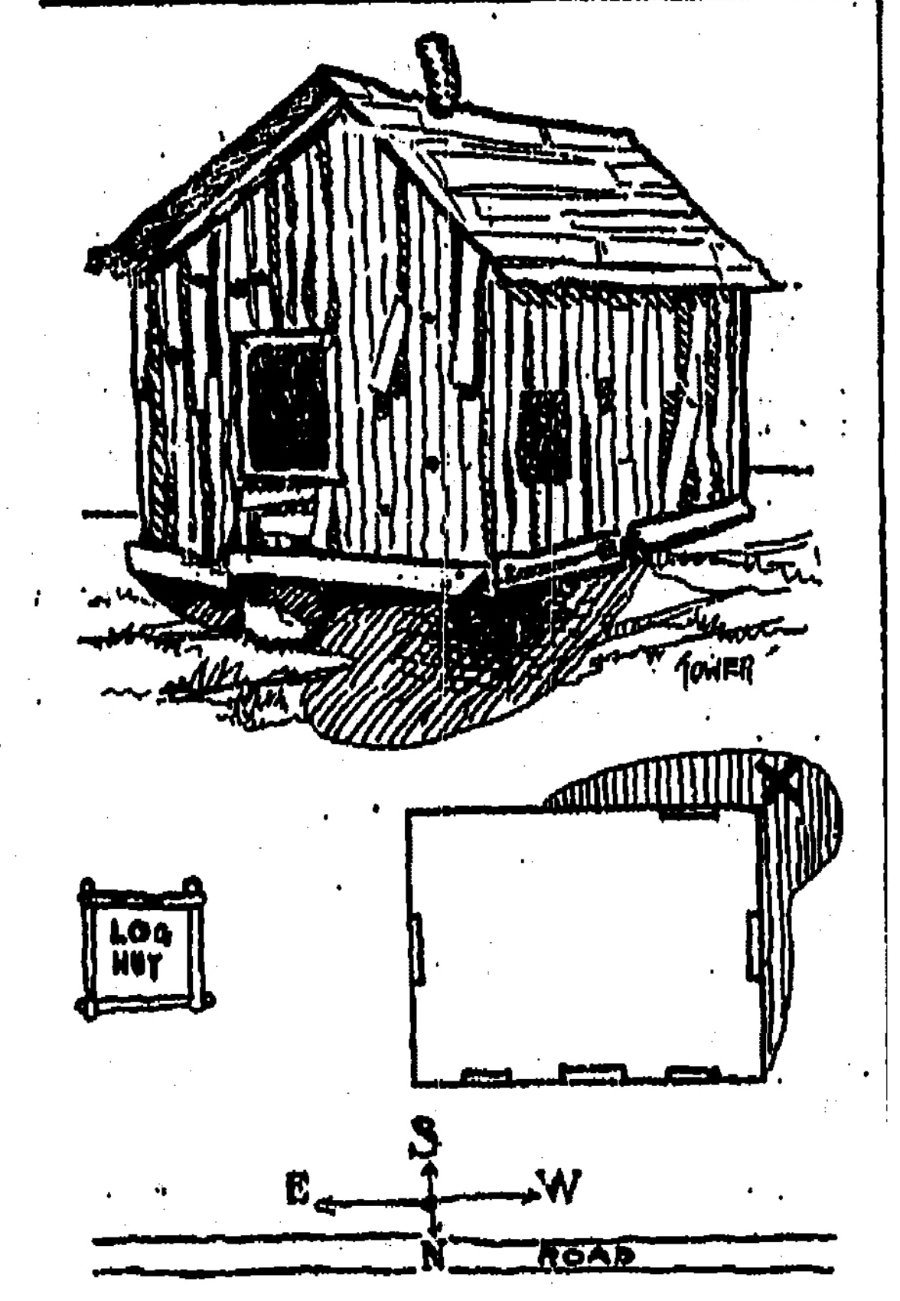
House on "Sand Plains". Shaded portion shows where skeletons were buried--The Evening Press 5 Oct 1904
"Here they discovered two well preserved human skeletons, evidently of adults. The news quickly spread and Sunday a large crowd of people went to the scene and begun to dig. They soon unearthed two more skeletons. Physicians who have examined the four skeletons have decided that they have not been buried many years and there is a mystery as to the identity of the persons."
"Search is being made for more skeletons but none has yet been found. This section was, a few years ago, a wild place, where outlawry was rampant and it is thought possible that the four persons whose remains have been found were victims of bandits. There is no burying ground near the place where the remains were found and never has been one."
A second updated report in the same paper was given front-page prominence, "MURDER OF EIGHT--Revealed by a Ghastly Find in Cellar of a House.--SPARTA HAS MYSTERY..." New details were relayed, "Excitement has been at a fever heat here since the discovery of the first four skeletons under the Burleson house, on the sand plains three miles east of here, as told in another column in this paper," as they found four more skeletons. "The first four skeletons were brought to this village, where they are now on view." Oh my!
Speculations swirled in print under Tuesday's banners: "NEVER SEEN AGAIN--Many Travelers Met Death on Sand Plain," wherein the staff corespondent submitted a report. "Further aroused over the skeleton mystery by the presence of Deputy Sheriffs Greenley and Pettis, the people of Sparta are today discussing little but the strange discovery, and offering theories to account for it. Many believe these bones are the grim evidence of terrible and wholesale crimes. Chief among these are the medical practitioners of the town, including Dr. Charles G. Pratt and Dr. Gillet, as well as Dr. S.W. Haines, the dentist..."
The medical experts determined all but two of the skeletons were adults and met their demise by a bullet to the head. Some visitors to the site were said to have carted off skulls and bones. "To account for the find, many stories of disappearances and outlawry in the olden days are revived. All agree that the neighborhood of the sand plains, about three miles northeast of Sparta, has an unsavory reputation, and that years ago some of the people who lived there were exceedingly dangerous characters. Years ago, so the old settlers say, a woman of unsavory reputation kept a tough resort in the neighborhood and there were many ugly stories afloat concerning it. This woman afterwards moved to Sparta then went to parts unknown. This character was known as "Queen of the Plains." Others said to have disappeared included a peddler and a cattle merchant.
George Wesley Burleson
Eli & Betsey (Helsel) Burleson were George's parents--his birth occurred in 1873 at Allegan. When he was twenty-one, George married Dora Agnes Palmateer on December 4, 1894, at Sparta. Just started out in life together, the young couple worked to make the hut on the sand plains their home. It was a coincidental misfortune that the disturbing find was made at the small house where George once lived. By then, he had already left the area for a teamster job at Mancelona in Antrim county, Michigan several years prior. By 1910, the Federal census recorded him as a policeman in Grand Rapids.
George Spaulding
A "well to do and respected farmer, who lives near the hut where the bones were found," George Spaulding remembered a man--maybe more--who were believed to have met with foul play at a house on the sand plains. Farmer Spaulding's home and 80 acres was located at the southwest corner of Long Lake and Indian Lakes.
George was born on September 19, 1862, in Ontario, Canada, to Joseph Lovell & Sarah (Hoparotall) Spaulding. When he was eighteen, the family migrated to Sparta where in 1884, he wed Rosetta H. Mapes, a daughter of Nehemiah Myron & Syrena (Scaddin) Mapes. The Spauldings were blessed with three children: Bertha (who became the wife of Otis G. Hanna of Cedar Springs), Clarence, and Laverna A. (who married Milburn H. Traxler) both Sparta residents.
Myron was a Sparta pioneer, who in his younger years was considered to be an excellent ox teamster "and was able to split 100 rails in a day. He was an expert axeman and tells of cutting pine trees more than four feet in diameter," according to a 1926 Grand Rapids Press feature. In his latter years Mr. Mapes was affectionately known as "Father Time".
In October of 1912, an interesting three-way trade involved Mr. Spaulding's 85 acre farm which was transferred to G.E. Spicer for his "house and lot in the Stebbins addition" of the village. Spicer then split 40 acres and the house off the Spaulding parcel for Arthur Hazelton in exchange for his lot and house near the schoolhouse (north across the street from the Spaulding farm) with the three family house shuffle being completed by the 15th of November The Sparta Sentinel-Leader reported.
William S. Bass
Mr. Bass resided "within a quarter of a mile of the hut, has been a resident of the neighborhood for about forty-nine years. He cannot recall that there has been any one killed to the definite knowledge of any person, pointing out the fact that all the stories of disappearance, with the exception of that referred to in the affidavit in Mr Beebe's possession, are indefinite. In his opinion, further digging would reveal more skeletons."
A native of Greenfield, Massachusetts born in 1835, Mr. Bass settled at Sparta in 1868. Here he "purchased 154 acres of unbroken wilderness, which he has brought to a highly credible condition of improvement and profit; has increased it to 218 acres," stated his profile in Polk's 1881 Atlas. William's 1875 marriage to Charlotte, daughter of Lovell & Sarah (Hoparotall) Spaulding, also made George his brother-in-law. The couple had two children, Theodore L. and Mary S.
Charles William Traxler
Another neighbor, just over the line in Algoma township was "Charles Traxler, who also lives near at hand, declares that five other skeletons were found a few years ago not far from this locality. He states that the skeletons were at that time supposed to be the remains of Indians. He also relates that two skeletons were found by George Burleson when he began to build the hut at the side of which these bones were found."
"Deputies Greenley and Pettis returned to this city this noon. They are mystified, although they do not think that there is a crime which it is at all possible for them to ferret out."
On Wednesday, more details emerged in print under the title "PLACE IS SPOOKY--Sand Plains Are Desolate and Almost Uninhabited.--CRIME IS IN THE AIR--Skeleton Mystery Has a Very Good Stage Setting.--Tumble-Down Huts Were Nearly All Deserted Years Ago-No Crops of Value." The Evening Press correspondent continued: "The sand plains in which the skeleton mystery has developed is the most desolate and forsaken of country districts. Even now, after the civilizing influences of half a century. It still remains bleak and forlorn. Its fields, if they may be called fields at all, are stretches of sand diversified by old stumps and are productive of sand berries and poverty. The houses in the neighborhood do not, almost without exception, deserve to be called houses at all. On either side of the sandy road are plain board huts, unpainted, and even these are quite far apart. They are one-story affairs, with boards running straight up and down and untouched by lath and plaster. As one drives along the road he passes an occasional hut which has apparently been long deserted, its old inhabitants having died in the midst of their poverty or having forsaken the spot."
"In the light of its present condition, what this dreary place may have been long years ago when the bones were first buried is left for the oldest settlers to tell, if their traditions run back so far, and for those younger to conjecture. Certain it is that those who lived there could have had little means of livelihood that was honest, and any one who was so foolish as to tarry there took his life in his own hands."
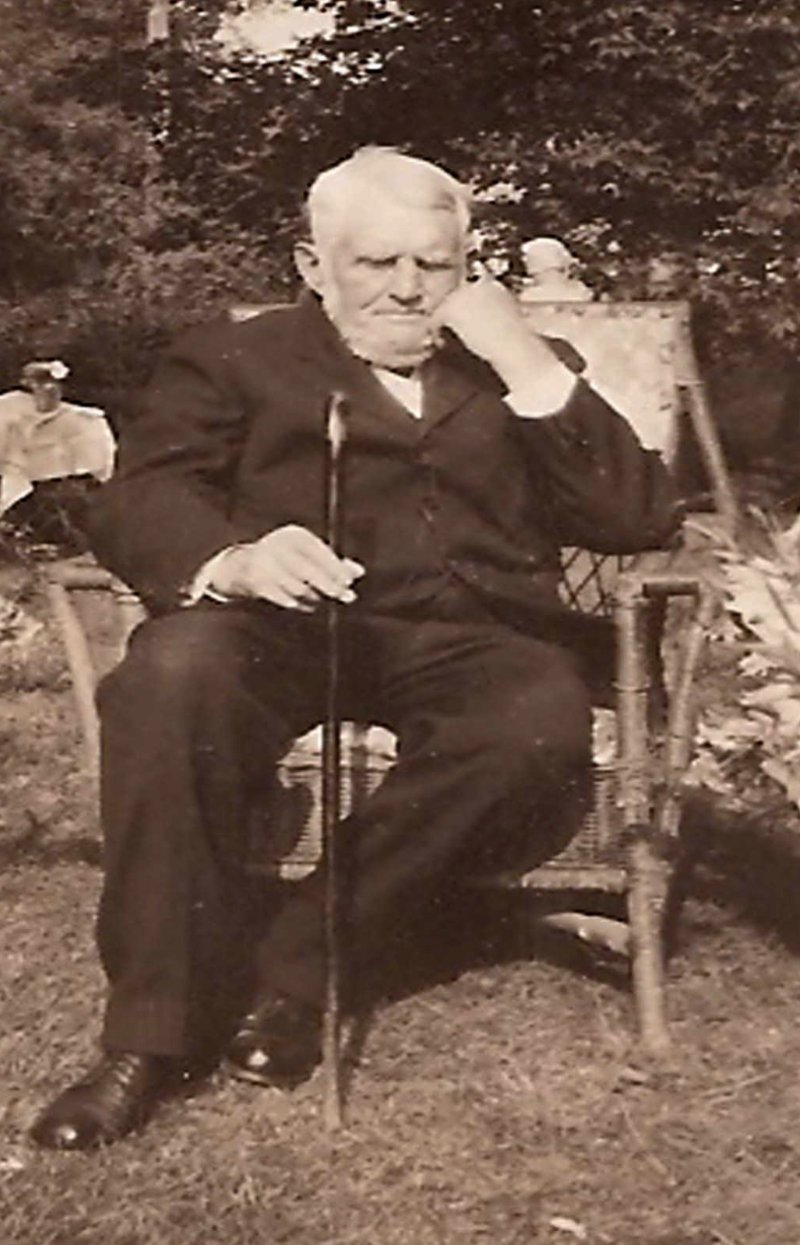
Justice Oscar Beeby--courtesy of Ann Kreis
Monday, a week after the initial discovery was reported, Sparta's Justice Oscar Beeby traveled to Grand Rapids to meet with Prosecuting Attorney Brown to present an "affidavit which tells of a murder in the Sand Plain neighborhood." The document was dated about twelve years prior.
Justice Oscar Nathan Beeby
Oscar was born at Central Square in Oswego county, New York on September 20, 1835, the son of Jacob & Electa (Snow) Beeby. In 1854, he graduated from Falley Seminary at Fulton, New York. When the call for soldiers came in the war of the states, he served in the New York militia and was able to remain at home to tend the farm as he raised hops and tobacco. Married life began in 1863 when Josephine Elizabeth Gardner caught his eye and captured his heart. She was the daughter of Daniel C. & Melissa (Harwood) Gardner whose family arrived at Sparta in the 1860s. Josephine's siblings included sisters Carrie G. (married Allen Martindale), Leta Adelle (wed Jonathan Edward Nash), and Emma S. (wife of Cary E. Buck) along with a brother, Frank.
In his thirties, an interest in public service took root when Oscar served as inspector of elections at Hastings before his own election as a town supervisor in 1869, 1870, and 1876.
In 1882, he came to Sparta and settled on a farm of 160 acres just east of the village limits which extended just to the edge of the Rogue River in one corner. Sparta creek, which was later renamed 'Nash' meandered through part of his pasture. In May of 1891 he filed a lawsuit in circuit court "to restrain the Chicago and West Michigan railway company from constructing a sewer leading from outbuildings on the company's premises at Sparta and conduct impurities into a stream of pure spring-water running through the pasture lands of the complainant." The Grand Rapids Herald reported, "He is in the dairy business and sells milk in Sparta and vicinity and the spring brook is the only source of water for his stock." In 1912, when Oscar was 77, he relocated to the village.
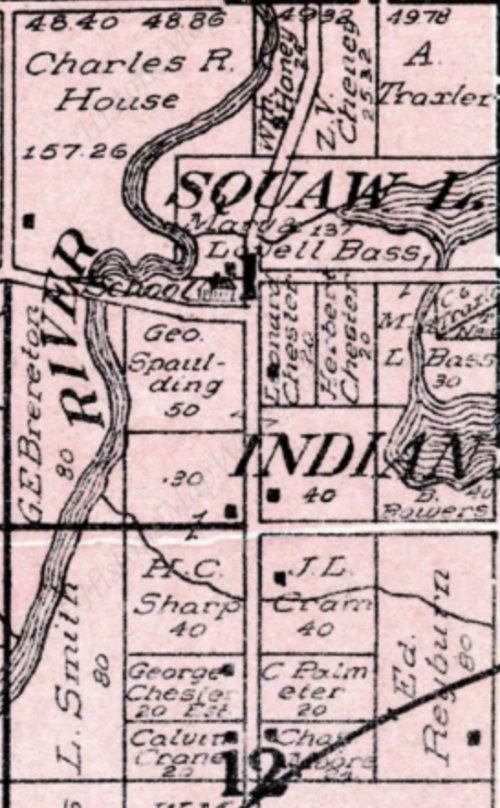
1907 atlas of the sand plains area in the far northeast portion of Sparta township
Remarkably, the judge lived to the age of ninety-three and his Grand Rapids Press obituary (14 Nov 1927) stated he was not only Michigan's "oldest justice of the peace" but also "the oldest resident of this place". It went on to say, "For more than 35 years he was justice of the peace in Sparta township, was active in community development, and was a member of the Baptist church and Sunday school." At the time of his demise, Oscar was a widow and with the exception of a daughter, Grace, who was a Sparta librarian, the rest of his children: Adeline, Daniel, Robert, and Edwin lived in other locations.
Location Clues
With details gleaned from various news accounts, the old Burleson house was on the south side of a small road headed back towards the river, west of what is now Long Lake Drive and south of 15 Mile Road. The hut was said to have been built on a mound, about forty feet from the road.
Captain Charles E. Belknap
The Captain "believes that the skeletons found at the Burleson house near Sparta are the relics of victims of a smallpox outbreak in a Rogue river lumbering camp back in the winter of 1866. He was connected with the lumbering operations in that country, and was familiar with the circumstances surrounding the outbreak."
"Some Canadians came to a camp on the Rogue river in the winter of 1865-66," said Captain Belknap. "Along in January smallpox broke out among them. The victims were taken to an isolated house near the site of the Burleson house. There some of them died. They were buried near the house, and the graves must have been shallow, as it was winter time and the ground was hard. There were women and children in the camp, and some of them were undoubtedly victims."
I am firmly convinced that it is the skeletons of these smallpox victims that are now being unearthed. If this is a fact, the finders had better be careful how they handle the bones as smallpox germs are notoriously long-lived."
"The theory that the skeletons are the remnants of victims of an Indian massacre does not seem logical. The Indians around here in the early days were not of the massacring kind."
Mystery solved?
Lumberjack
Tavern on the Rogue
While Sparta's pioneer families arrived to settle the township, lumberjacks toiled to harvest forests along the nearby Rogue River. Winter's ice gave way to warm spring breezes, as a hearty breed of woodsmen drove logs on the swollen river to sawmills downstream. Balanced on top of the floating logs, men wore spiked boots and were armed with long cant hook poles to grip and move logs. Shallows and bends in the river could cause log jams where the men had to move logs by hand or blast them loose with dynamite. The risky job of a river driver was, perhaps, the most dangerous in bringing lumber from forest to market. Most cheated death--but some did not.
Men who rode the logs were often farmers who felled and stacked trees at remote lumber camps during winter months then wrangled logs down wild rivers in spring before their fields were planted--for pay or sometimes in exchange for lumber to build their farms.
In 1904, The Evening Press, which was published from 1893-1913 and became the forerunner to The Grand Rapids Press, ran the following feature article:
- OLD BLOCK TAVERN
Landmark of the Neighborhood of Sparta.
RIVER MEN USED IT
Relic of the Day of the Lumber Jack.
Well-known Men of Today Knew the Place as a Rough One in Lumbering Days.
If certain old beams out Sparta way could be equipped with tongues and memories, they would tell a story which for historical interest would put many an old settler's yarn to the blush. These beams are old now. Some of them are rotting in Kent county soil, while other are serving their appointed purpose in the framework of houses and barns. But they once made up that one-time celebrated hostelry, the Block tavern.
Have you never heard of the old Block tavern? Quite likely; no one has seen it in its old glory for these twelve or fifteen years. It passed away with the good old log-driving days. Having once been a thriving hostelry, it degenerated into a respectable but uninteresting farmhouse, and then was torn down. Some of the very oldest men living up in the Sparta neighborhood may remember something of the early history of the old place, but there are few. If, indeed, a single one, who can remember when those old square timbers were piled upon one another to make a shelter for the rough woodsmen.
Men who are active in this generation, like Supervisors Billings and Holmes, and Charles D. Stebbins, cashier of the city water works department, know of its interesting early days only through tradition. While they were yet boys it had become marvelously staid and dignified as compared to its old self...
Who were Billings, Holmes, and Stebbins and what was their connections to Sparta?
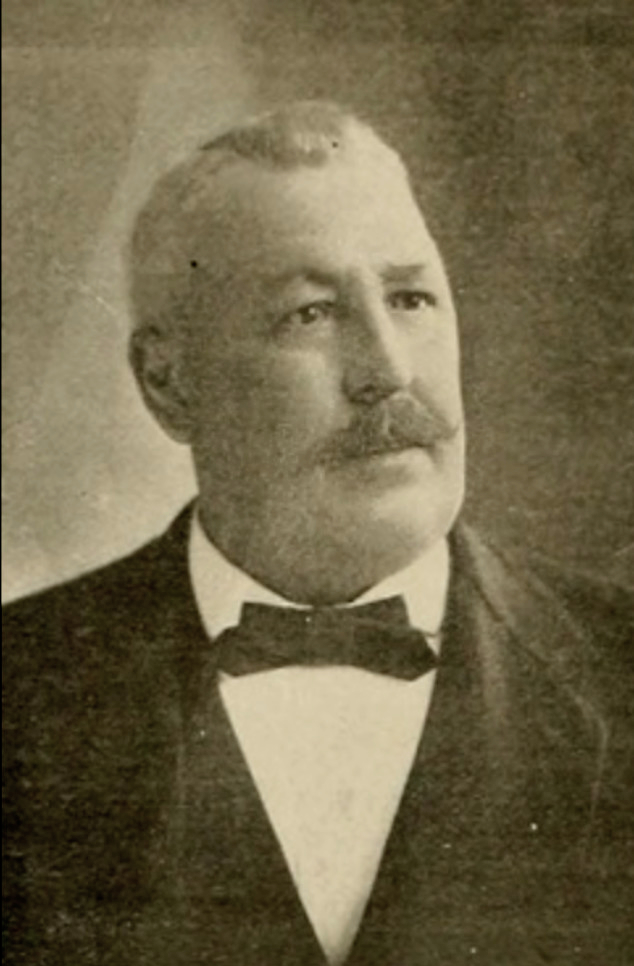
Charles D. Stebbins
Charles D. Stebbins
Born on August 3, 1838, to Gaius Partridge & Eliza (Ladd) Stebbins, Charles and his family migrated west in October 1846 from Georgetown, in Madison county, New York, to a farm near Sparta. The grandparents, Gaius & Mariam (Orcutt) Stebbins, joined their family and made the trek to resettle. The elder Gaius, born in 1781, served as a Lieutenant Colonel in the War of 1812 then was later Colonel of the Militia for the state of New York. The younger Gaius was a Major in the New York state troop. In 1848, Gaius P. Stebbins was appointed Postmaster for a tiny settlement called 'Somerville' two miles south of Sparta where he handled the duties from his home. After that post office was closed, he was appointed Postmaster for Sparta Centre in 1854 and in 1859 became a Justice of the Peace in Kent county.
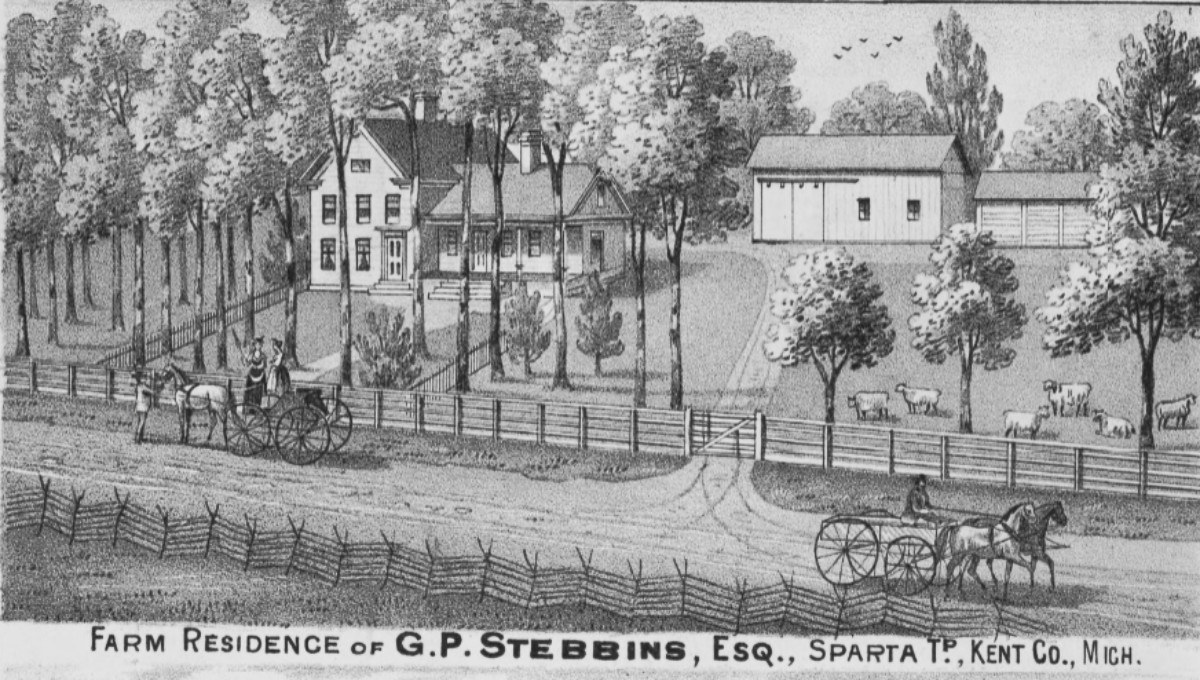
The Stebbins home located two miles south of Sparta from the 1876 Belden & Co Historical Atlas
The boy grew to manhood on his father's 160 acre farm in Section 26 at the northeast corner of what is now 11 Mile Road and Sparta Avenue. In addition to farming, Charles worked in the sawmill and lumber business as a young man. Quite likely it was at the 'Stebbins' mills' on an 110 acre wooded parcel of land owned and operated by his brothers, William G. and Andrew Jackson Stebbins in Section 1, which is the far northeast corner of Sparta township between Long Lake Drive, Squaw and Indian Lakes.
In 1865, Charles wed Sarah, a daughter of Joseph & Eliza (Holliday) Fitch of Laphamville (now Rockford) in Algoma township. The newlyweds began their family as they cared for his elderly parents on the family farm--which he would later own.
Charles was well-known and well-liked as a well-to-do farmer who took an interest in township affairs and invested in local furniture manufacturing companies. He entered politics in 1884, won the race for Sparta township highway commissioner, and afterwards, served as Kent county treasurer. A decision was made to pursue public service and Charles was elected to the offices of Grand Rapids city treasurer, then, in 1894, became Mayor.
On 22 Jan 1908, Charles passed away. Newspapers remembered him as "a man of strong character and kindly disposition" and those who served with him in politics noted he was "an upright and capable official, a good citizen, and a man loving his home and family".
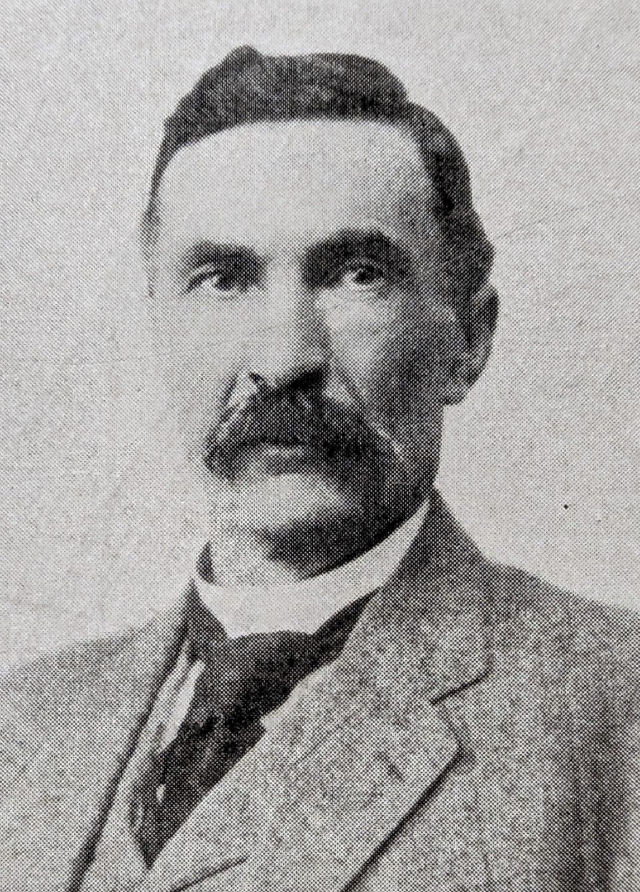
Vernon H. Billings
Vernon Hubert Billings
A son of Sparta, Vernon was born on January 25, 1860, to Calvin Isaiah & Mary Melinda (King) Billings. The boy was raised on his father's 160 acre farm in Section 8 on the southeast corner of Peach Ridge and 15 Mile Road near Manchester schoolhouse.
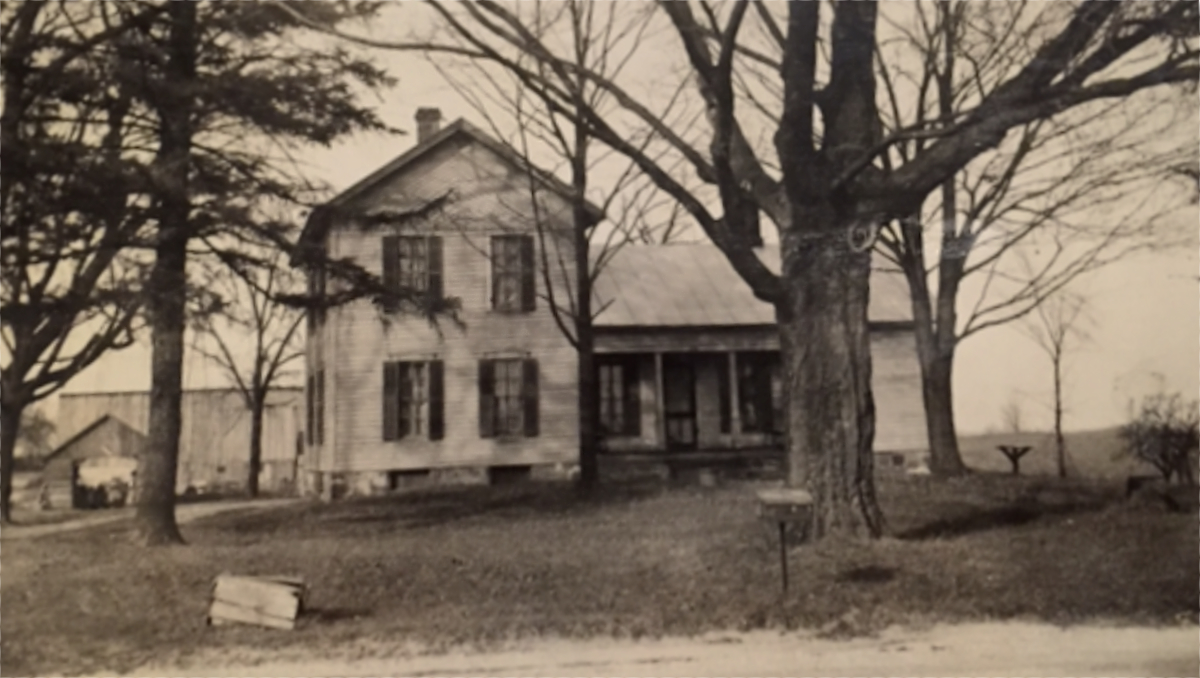
V. H. Billings home on 15 Mile Road
At twenty-two, Vern took Cora J. Johnson as his wife--the daughter of Minor Titus & Caroline M. (Reynolds) Johnson and they made their home on an 140 acre farm situated on the north side of what is now 15 Mile Road between M-37 and Sparta Avenue. A farmer by trade, Vernon became interested in politics and was elected to the Sparta Township board of supervisors and later as a county supervisor, a position he held for fifteen years.
Vernon possessed a genuine concern for the less fortunate members of society. By 1910, the Billings had relocated to Grand Rapids as he was named the County Superintendent of the Poor.
An article, "Moonshine Patients Have Slight Chance", that appeared in the Detroit Free Press (29 Mar 1921) quoted him as saying "Moonshine patients" at the Kent county infirmary are there to stay... in contrast to the old type of habitual drunkards who went to the farm and remained until they were well and then were discharged. Those who go there now because of drink are generally so thoroughly demoralized due to moonshine and other homemade concoctions that they become permanent residents."
William Oscar Holmes
Life began in 1861 at Pittston, in Luzerne county, Pennsylvania for William, the son of Albert Newberry & Julia C. (Dershimer) Holmes. Seeking new opportunities, in 1869, Albert brought his family to an 120 acre farm on Crockery Creek in Tyrone township, about a mile southwest of Kent City. In 1886, as construction of a new home to replace the original log cabin was completed, Albert passed away. William took the reins of the family farm. For seventeen years, he also served as a supervisor at the county level and for Tyrone township.
Was the reputation of the Block tavern more fact--or fiction?
- Was a Rough Place.
The old "block" was a rough place. There is no question about that. Every one will tell you so, whether you are up in its neighborhood chasing an elusive skeleton mystery upon the sand plains, or whether you are there on a more peaceful mission. It couldn't help but be rough and tough in the great, good-natured, uncouth way of the old river days. Thither the log drivers came with their spiked boots and tremendous thirst, and whiskey flowed like--not like water, for water never flowed so cheerfully and so swiftly down human throats. Then followed fist fights, and other kinds of fights, so tradition says, and interspersed with the drinking and fighting there was dancing of the rollicking backwoods sort.
Yes, the rough river men were the chief patrons of the hostelry, but occasionally there mingled with them the immigrants who had stopped their white schooners there for a little respite. Sometimes there came, too, the outlaws, so Deputy Sheriff Pettis insists--men who were fleeing from the sterner justice further south and east...
Deputy Sheriff Edwin Pettis
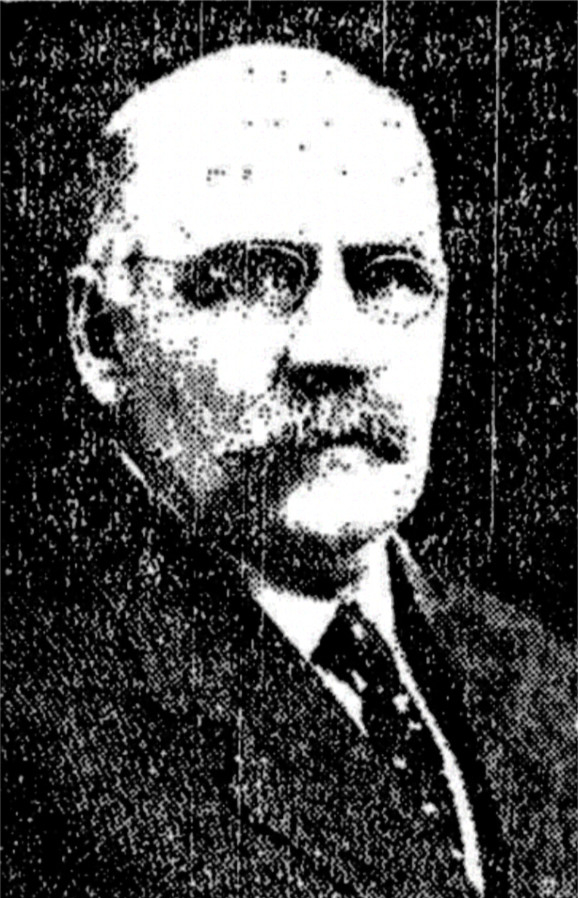
Undersheriff Edwin Pettis
"Ed has a story for every minute of the day regardless of the length of the day," quipped The Grand Rapids Press. "To spend a few minutes with Ed means a sure cure for the blues and is just as restful and refreshing to a tired piece of humanity as is a check from father." Undersheriff Pettis was famed for his storytelling.
While still a wilderness, Edwin was born at Ada, Michigan, in 1856, on the family homestead next to a flowing spring which traveling Indians would frequently visit.
His early career life began expertly navigating rivers with log rafts to transport produce to Grand Rapids. Later, he earned a living as a brakeman on the Chicago & West Michigan railroad at Newaygo and in Grand Rapids as a trolley car driver. Eventually he became undersheriff, then police captain for the Pere Marquette Railway Co. for thirteen years. Under Edwin's leadership in the role of chief special agent for the railroad, he cleaned house as his corps of officers investigated and exposed employee larceny. After retirement at 70 years, Edwin was a safety vault officer for the Michigan Trust Co.
So, where was this boozy brawling bar of barbarian lumberjacks actually located? Is it even possible to determine where? With a little 'detective' effort... yes!
The article provided some useful clues...
- On the State Road.
Convenient to the river bank, and not more than fifty or sixty rods away was the old tavern. It faced, too, the old state road leading to Muskegon. It was a building about thirty feet wide by about fifty feet long, and was named for its peculiar construction. Here again, Deputy Pettis gets in his good work, stating that the hotel was named because it was a block house in the old sense, having openings in the rough walls through which the besieged inmates shot... Others make the more prosaic explanation that the house was named because of the beams used in its construction. All of the walls were made of great log "blocks", made by hewing logs until they were square.
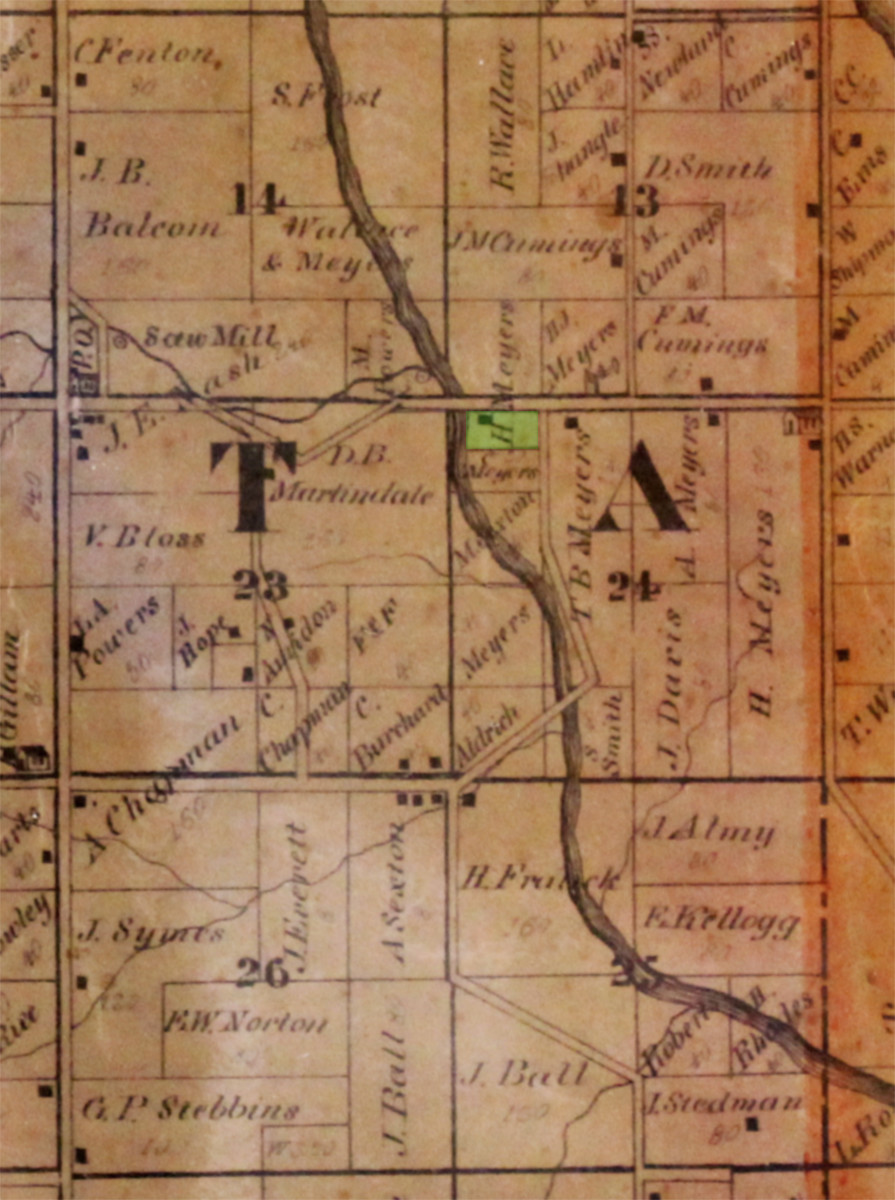
The location of the Block tavern on 13 Mile Road is highlighted in green on property owned by "H. Meyers" from the 1863 Sparta Township plat map published by Randall, Harney & Co. The "Myers" family name was mis-spelled on this map. Also of interest is the "G. P. Stebbins" farm in the lower left hand corner with the home facing Sparta Avenue--courtesy of the Karl Nickolai Collection
"Fifty or sixty rods" translates to less than 1,000 feet distance from the banks of the Rogue River and the "state road" is known as 13 Mile Road today. Viewing early plat maps of the area from 1855, 1863, 1876, 1894, and 1907 the placement of the old tavern was most likely on the south side of the road, just east of the river. In 1855, the east bank property abutting the river on both the north and south sides of the road appears to be owned by "C. Myers"--Charles Myers and suggests it was the Myers men who built the log building. By 1863, the parcel of land was owned by his son, Hiram Myers, with a structure identified close to the river. He sold it by 1876 to his widowed sister, Caroline Wallace. It was the residence of Frank Miller in 1894 who operated his blacksmith shop and a cider mill at the location. He still owned the property in 1907, but by then the building near the river had been torn down.
Another "clue" as to the origin of the infamous Block tavern was gleaned from the writings of Henry M. Sleeper, an old timer who penned letters of his reminiscences published in the Sentinel-Leader during the 1930s. A man by the name of "O. Hoag" ran a large hotel at Sextonville, but then moved up to the banks of the Rogue River one mile east of Sparta to run the Block tavern. "Here he conducted a refreshing business. Those were the old license days, and of logging and river drives." Henry reflected, "I am quite sure Hoag would not insist on his patrons going to the river to drink. The floors of that old hotel will always remain as a witness to those days of rivermen's spiked boots. Some might ask how I know. Anyone familiar with the history of those days will know. And those who don't are at liberty to draw their own inference."
- Style of the Building.
The building was a scant two stories in height in the main part. After the first part was erected, a little lean-to was put on. The lower part of the building was used for the tavern living rooms, the chief part of which was the bar. Upstairs were the sleeping rooms.
So far as can be learned, the upstairs part was not used much. When the log-drivers went to the old tavern they did not go for sleep, and they did not give others much chance to sleep, either. When they gathered here they began with drinking and dancing, and wound up with a jolly good fight, during the course of which the spiked soles of their shoes came into play upon one another's faces. Mr. Stebbins, who spent his boyhood in the neighborhood, stopped at the tavern during one of these "parties", when about seventy-five log-drivers were pretty well "liquored up" and ready for business. At another time he drove past the "Block" after one of the fights, and declares that the snow was red with blood, looking very like the snow upon which there had been a hog killing.
Was a Wild Neighborhood.
The wilderness and ferocity of the place is well illustrated by a story of the adventure of a man who now lives in Grand Rapids. Having journeyed beyond the "Block" on business, he was nearing it again on his return trip. The night was dark, and the snow was three or four feet deep, obscuring the road and making travel most difficult. Suddenly from out of the darkness ahead there came a blood-curdling shout, which frightened the youth to a sense of his danger. There he was alone in that dangerous spot, with a ruffian in front of him, with no opportunity to escape, and with no weapon. The ruffian drove nearer, muttering as he came. His sleigh came up to the sleigh in which the youth was trembling. When the drivers were opposite each other, the villain could almost have reached over and struck his victim. But he had a better weapon than his fist, and at this deadly range he ruthlessly prepared to use it. He reached around to his hip pocket and pulled out--a bottle of whiskey.--The Evening Press, Grand Rapids, Mich. (12 Nov 1904)
Capt. Charles E. Belknap:
The Blacksmith Congressman
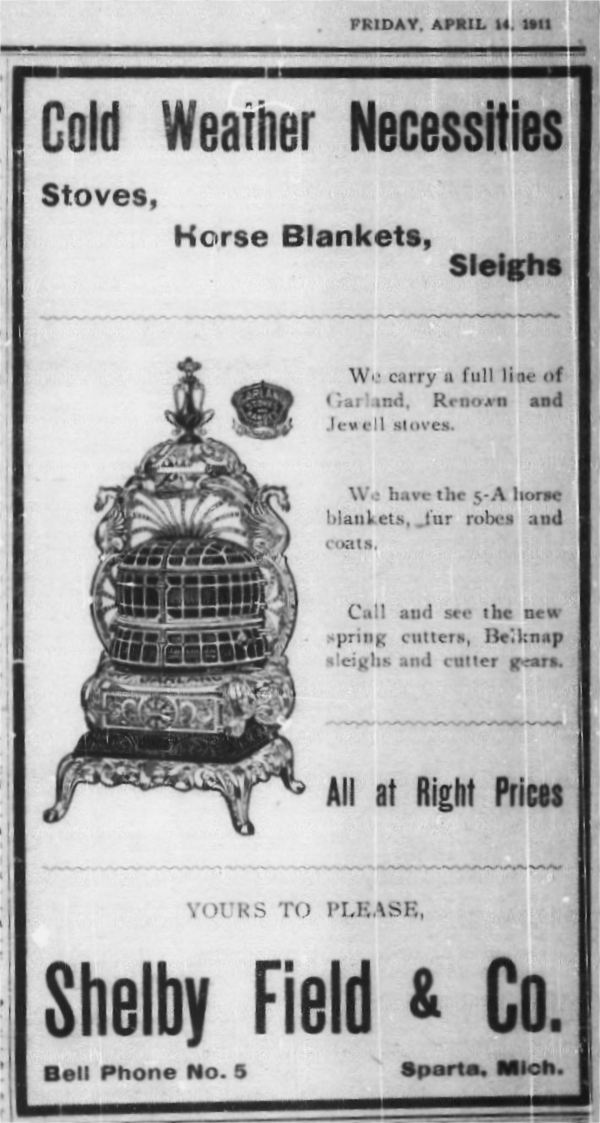
Shelby Field & Co. advertisement for Belknap Sleighs and Cutters from the Sparta Sentinel-Leader on 14 Apr 1911
Editor's note: Arzie Pinckney wrote a story about his memories of hitching a ride on the back of a horse-drawn sleigh at Christmastime on the streets of Sparta when he was young. While searching for a photo of a sleigh, I happened upon not only the story of the sleigh, but of the man who built them.
Reading through old Sparta newspaper advertisements and auction notices, it is clear that one of the most popular sleighs--if not the most popular--sold in the village was a 'Belknap'. Interestingly, the patented sleighs were built nearby in Grand Rapids at the Belknap Wagon and Sleigh Company, a large four-story factory on the west bank of the Grand River at First Street and Front Avenue founded by Charles Eugene Belknap. Does the name ring a bell?
It should if you're familiar with Grand Rapids, Michigan.
Born on October 17th, 1846, at Massena in St Lawrence County, New York, Charles traveled to Michigan in 1854 with his parents, James Albert & Mary Ann (Butler) Belknap, and family. "We came to Michigan because the government had given my grandfather a quarter-section of timber land as a reward for his services in the war of 1812," Charles later wrote in The Yesterdays of Grand Rapids. The Scottish grandfather, John Joshua, served in Captain Flanders' Company of New Hampshire Volunteers and his bounty land was located on the Ottawa County side of Kenowa Avenue at Jamestown (Section 6).
"Father came to do the iron work on the boats being built in the shipyard." The family's arduous journey "by stage, river, canal, lake, and railroad" led to Chicago, "then known to the Indians as Chi-cog--"skunk water." In the getaway from this rightly named place we secured passage on a lumber schooner for Grand Haven, sleeping on the deck without blankets; then by steamer to Grand Rapids." Upon their arrival, the father, a master blacksmith, forged his trade near where the Pantlind Hotel would later stand sentinel alongside the Grand River. A few years later, James relocated his business across the river.
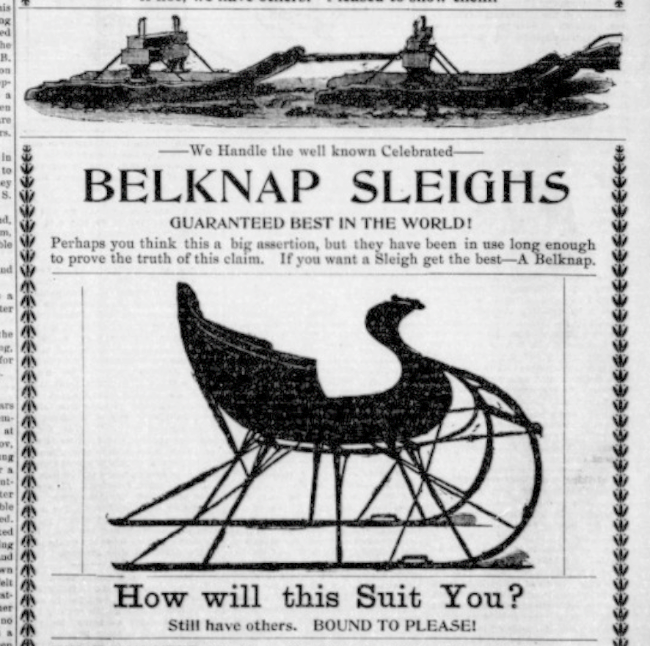
By 1900, Captain Belknap was the second largest manufacturer of sleighs in the United States. The "Celebrated Belknap Sleighs--Guaranteed Best in the World!" ad was published on 2 Dec 1898 in The Evart Review
The son apprenticed with his father and learned the trade. The first volume of Williams' Grand Rapids Directory, City Guide, and Business Mirror compiled by C.S. Williams in 1859 listed the thirteen year-old as a "blacksmith". At the outbreak of the Civil War, James closed his forge and enlisted into Company H of the 8th Michigan Infantry. "Too young," was the response when Charles attempted to join, so he reopened his father's business and pressed on.
Unwilling to give up, Charles convinced his mother to grant her permission for him to join the Army in exchange for a promise he would avoid tobacco, whiskey, and card playing. On August 12, 1862, just two months short of his sixteenth birthday, Charles mustered in at Ionia to serve with Co H of the 21st Michigan Volunteer Infantry as a Private. Over the next thirty-four months, he was in no less than sixty-three skirmishes and received seven wounds: three at Stone River where he rescued his regiment flag when the color bearer was shot; and four additional times at the Battle of Chickamauga--"where the bullets fell thickly". Recognized for courage, Charles swiftly rose to the rank of Captain by the spring of 1864, at just seventeen years of age. He was mustered out in June of 1865 after the war ended and planned to make a career in the military. Weeks later, he passed an exam and was offered the position of first Lieutenant in the cavalry, but with a change of heart he decided to turn it down.
Charles was needed at home.
James also survived the war but suffered multiple severe battle injuries. Captain Belknap returned to west Michigan and rejoined his father in the smithy profession. From raw material to finished product, Charles was a skilled tradesman. Business listings for "Belknap Capt. Charles E., blacksmith" with a second in his name as an "iron forger" and "Belknap, James A., blacksmith" appeared alongside Charles' brother, "Belknap, John J., printer" in the 1865 Grand Rapids City Directory, all at "17 Water". However, it soon became apparent the father's afflictions would necessitate his retirement.
A decision was made to sell the Water Street property and a farm was purchased from Andrew Myers in Sparta Township. At Christmastime in 1866, Charles, a resident of Sparta, married Miss Chloe Mabel Caswell. The 1867 Holland's Grand Rapids Directory confirmed James and Charles had left the city where John remained and worked as a pressman at the Daily Eagle while he boarded at 16 Turner Street.
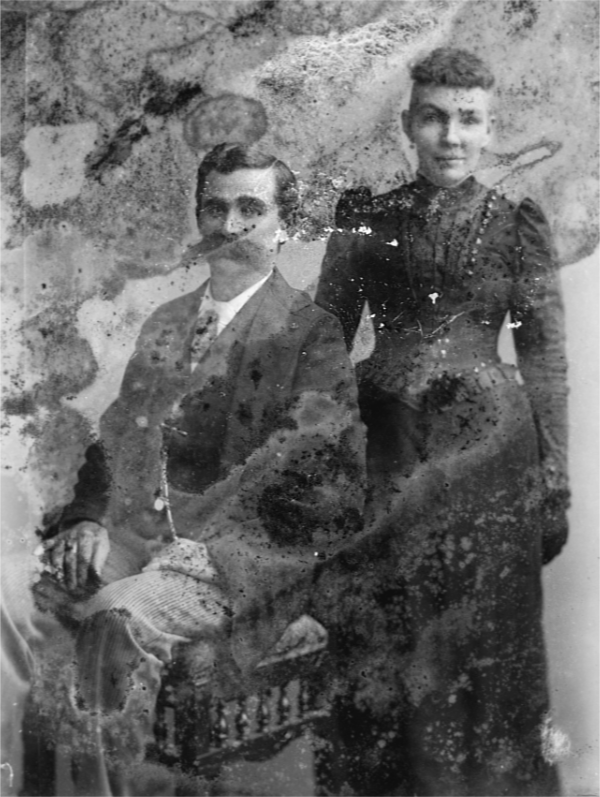
Congressman Charles and Chloe Belknap portrait by C.M. Bell Studio taken in Washington DC (1891)--courtesy of the Library of Congress
The newlyweds soon began their family with three of their four daughters born at Sparta: Bertha in October 1867, Helen in August 1869, and Jennie in August 1870. Birth records stated Charles was a farmer and blacksmith. The youngest daughter, Grace, joined the family in July 1872 at Grand Rapids.
According to the Dillenbeck & Leavitt 1870 Kent County History and Directory, the Belknap farm was located in Section 24 of Sparta Township. It was the 80 acre parcel on what is now 250 13 Mile Road just west of Hiram Myers' farm and Myers Schoolhouse. On August 27th, 1870, the enumeration of the Federal Census valued Charles' farm at $4,500 and his personal property as an additional $1,300. He raised 225 bushels of winter wheat, 100 bushels each of Indian corn and oats. The Belknap farm produced 13 bushels of peas and beans, 100 bushels of Irish potatoes, fruit, 400 lbs of butter, and 20 tons of hay. His parents and youngest brother, Herbert Pengally Belknap, also resided on the Sparta Township farm. With the help of a brother-in-law, Hiram Caswell, Charles farmed while his father had "no occupation".
Three days later, James passed away.
In the following year, after his father's death, Charles exchanged his plow for a full-time forge as the Belknap family returned to Grand Rapids, but it took another year for their farm to pass into the hands of new owners. From a copy of the deed dated 23 Apr 1873, Charles and Chloe sold their 80 acre Sparta farm for $3,000 to Edgar S. Dart of Farmington in Oakland County, Michigan. Mr. Dart increased the size of the farm to encompass 120 acres and remained there until shortly after 1900. The next owner was John G. & Carrie (Anderson) Johnson--and the family owned the farm for the next 100 years.
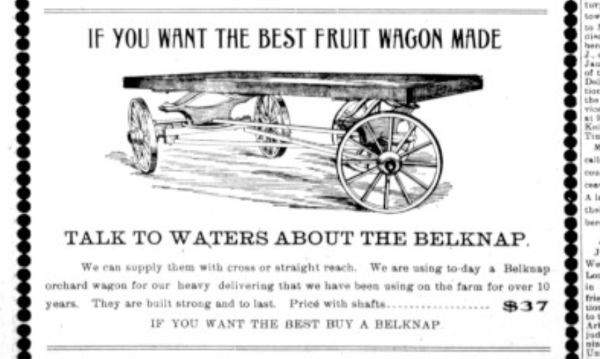
With a price tag of $37.00, Belknap's innovative Orchard Wagon was one of more than three dozen styles of speciality wagons his company manufactured as seen in a 13 Jul 1906 advertisement from Paw Paw's True Northerner
While at Sparta, the Belknap neighbors included: Thomas Myers, James Shangle, Abram Tufflemire, Joseph Clackner, Levious Withey, brothers Frederick and Marcene Cummings--most of whom were also Civil War veterans. Tufflemire, Shangle, and Fred Cummings were in the 1st Michigan Engineers Co., a unit with which Charles spent time assisting early on in his tour. Sabra, the wife of Marcene Cummings, was the sister of Lieut. Amherst B. Cheney, also of the 21st Michigan Infantry. (See the Civil War Letters written by Cheney.) Joseph Clackner Jr. was a Sergeant in the same company of the 21st as Charles.
Even though Charles made the decision to leave, a life-long fondness for Sparta and friendships remained.
Establishment of his rightful place among the iconic manufacturing companies positioned along the banks of the Grand River came about quickly. "In 1871 we find Charles E. Belknap blowing the bellows at the forge and shoeing horses. Shortly afterwards wagons are made at this smithy," Albert Baxter wrote in History of Grand Rapids Michigan (1891). "In 1884 we find the Belknap Wagon and Sleigh Company organized, with an authorized capital of $100,000, for the manufacture of Farm, Freight and Express Wagons; Lumber, Mill and Farm Carts, and Logging Carts and Trucks, with Chas. E. Belknap, President and Manager, and H.P. Belknap, Secretary and Treasurer. The present works on North Front street, give employment to about 50 men."
His successful firm expanded to include structures on both sides of Front Avenue while the number of employees increased to more than 100 men.
In addition to his industrial pursuits, Mr. Belknap was a founder of the Grand Rapids Fire Department and rose to prominence in politics: the board of Education, Alderman, Mayor, board member of the School for the Deaf at Flint, and he served two terms as the Michigan 5th District United States Congressman.

General Wheeler's order to shoot Captain Belknap from the 16 Jul 1892 Cheboygan Democrat, reprinted from the St. Paul Globe
- Wheeler's Order to Shoot Mr. Belknap
published on 16 Jul 1892 in the Cheboygan Democrat
There was a strange incident in the room of the house committee on military affairs the other day, when General Wheeler of Alabama, brought out an old order book to show to Mr. Belknap, of Michigan, in which was the copy of the standing order that one Charles Belknap, of the Twenty-first Michigan infantry, be shot if captured. It was the sequel to a war time story. Mr. Belknap enlisted at sixteen. He doesn't look thirty now, with his straight figure, bright eyes and military brown mustache, but in war time he was as dashing a daredevil as ever lived. One night, just for the fun of it, he mounted his horse and rode boldly through the Confederate lines to the headquarters of General Wheeler, who was commander of the western Confederate cavalry. The tent was empty.
Young Belknap threw his lines to an orderly, strode boldly in and deliberately pocketed all the dispatches and papers on the table. His very audacity saved him, and not a man in all the Confederate camp even thought to question him. Back he rode with the dispatches, to unlimited applause and a captain's commission at seventeen. Then it was that General Wheeler turned green and blue and white and red for rage, and for six months his soldiers had orders to shoot Belknap if ever he came within range again. Wheeler and Belknap are the best of friends, they serve on the same committee and delight in growing reminiscent of war times together.--St. Paul Globe.
Beyond his years in Congress, Charles continued at the helm of his business until retirement in 1916, amid a variety of appointments to serve in various civic and government capacities.
The Captain was generous with his time and became a popular keynote speaker primarily on the topics of history and patriotism for a variety of audiences of all ages such as: the American Legion, Boy Scouts, and school children, to name a few and he returned to Sparta for banquets or other events. In 1952, Carol Holmes-Kurtz fondly recalled him in her Sentinel-Leader column "Seeing Life" when she wrote: "As a child we remember Captain Belknap coming to school to talk to us in assemblies. He was one of our heroes as youngsters."
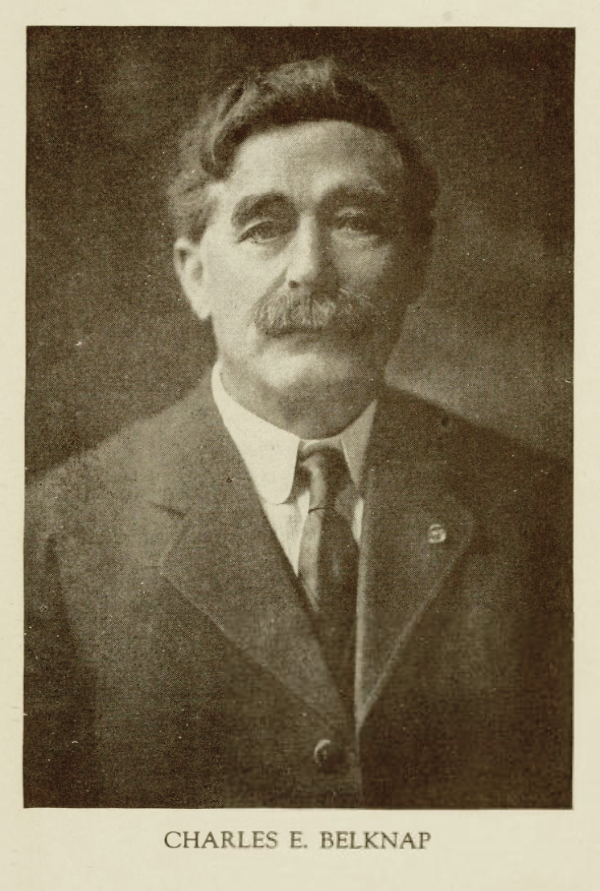
Author Charles E. Belknap portrait from his book, The Yesteryears of Grand Rapids--courtesy of the Library of Congress
His knowledge and passion for history inspired him to pen a series of articles which were part memoir blended with local history that appeared in newspapers--and later in book form as The Yesteryears of Grand Rapids, published in 1922. Not exclusive to the city, the author included vivid tales and insight into the early days on the Rouge River--and even mentioned some of his Sparta Township friends:
"Following the winding river it was a long paddle to the home of that good man, Dr. Sexton, who was an angel of mercy to all the inhabitants of cabins and mill shacks of northern Kent. A "God bless you" often paid the bill. It was all the pioneer could offer."
"At the last mill site on the river sprang up the town of Gougeburg," in Algoma Township's Section 28 where a dam once crossed the Rouge and a sawmill was erected by C.C. Comstock of Grand Rapids. "It never had or needed any other name. Besides its logging crews there were two lawyers, said by the lumberjacks to be hiding from the sheriff. When not tipping the jug they wove shingles and in public spirited way helped the town live up to its name."
"If a man succeeded in escaping from Gougeburg he reached beyond to the Meyers settlement, lying between the river and Camp lake; Hiram, Tom, Ben and Andrew, four brothers, three of them with large families, had come to stay and were making farms," all of whom were former neighbors Charles knew well. (The family is featured in the story of Meyers Schoolhouse.) "It was often said that no man ever went away from Hiram Meyers' homestead hungry and that Auntie Nicholas Emmons in their cabin on Camp lake served the most delicious fritters and maple syrup that man or boy ever tasted."
"At the far end of Camp lake was Snow's tavern. From here crows flying north carried haversacks with frogs for rations, for it was the jumping off place until the trail reached the Muskegon river."
On the 16th of January, 1929, Charles Belknap passed away--a greatly admired man that once called Sparta his home who left his mark on history. A bronze statue was dedicated to his memory in 1931 which is currently located at the intersection of Coit Avenue and Hastings Street in Grand Rapids. The memorial was Erected by friends who admired Captain Belknap's patriotic public services, his winsome friendliness, and simplicity, and the practical Christianity of his exemplary life.
One family's encounter with the Captain left a lasting impression--spanning a century--which truly speaks to the quality of Charles' character. "My father told me, as a young lad, he met Capt. Belknap. It was about 1920 when my father was with his grandfather, James B. Page (a Civil War veteran)," Michael Page related the memory handed down from his father, Charles P. Page. "Capt. Belkap said something to the effect of: Wow. You are the grandson of Jim Page? It's an honor to meet you. My father said Capt. Belknap made him feel important, special... something he remembered for the rest of his life. With all of his accomplishments (Civil War dare-devil, skilled businessman, farmer, politician, etc.) Capt. Belknap took the time to show kindness to a young boy and his grandfather. That is the kind of man Capt. Belknap was."
The Incredible
Dr. Sexton
What does the War of 1812, a doctor, a shipwreck, and a ghost town all have in common? At Sparta Township, the answer is a man named Dr. Isaiah Bliss Sexton.
Bliss greeted his parents, Charles and Abigail (Butler) Sexton, for the first time on July 18th in 1805 at the tiny town of Lowville, Lewis County, New York.
Shortly after the War of 1812 broke out, Charles entered Captain Moses Water's Company in Z. Carter's 101st Regiment of the New York Militia in March of 1813. Six months later, eight-year old Bliss joined his father as he enlisted to serve as a waterboy in September at Putnam, New York. Charles attained the rank of an "Orderly Sergeant" while Private Isaiah's pension declaration indicated he was a "Waiter". But I'm getting ahead of myself.
As a young man, Bliss lived at Otsego County, then a year later in 1825, he removed to Onondaga County, New York, where he wed Abigail North. He first came to Michigan in 1833 to Washtenaw County where he sought a new life. Sorrow cast a shadow on their home at Ypsilanti as Bliss' wife and two children died.
Back in New York, he married Eliza A. Everett, but Bliss was drawn to the mitten state. A sister, Phyla, and her husband, Simeon Rouse, lived at Alpine Township in Kent County. In 1847, Bliss appeared at Grand Rapids where he practiced medicine. The couple returned to New York where family still lived, and in 1850, he was enumerated as a "Physician" at Orleans in Jefferson County. His father, a "Miller", was nearby.
Charles' record as an officer during the war provided him with multiple parcels of bounty land in Michigan. He and Bliss, along with another sister and brother-in-law, Wealtha and Ichabod Gaylord Field, made the journey to Sparta. On the first of April, 1851, the elder Sexton patented a choice parcel provided for his service in the War of 1812; 40 acres fronting Pine Island Drive and Scott Lake.
Bliss took a job in 1852 herding cattle north on the "Newaygo trail" to Grand Traverse after which, "I embarked on the schooner J.Y. Scammon for Chicago," Bliss recounted in an 1896 interview with The Grand Rapids Press. "The schooner was wrecked in a storm and driven on the beach of South Manitou island. The vessel was driven so far up on the shore that we were eventually able to get on dry land without wetting our feet. The day after the wreck I got my baggage into a row boat and hired an Indian and a white man to row me around into the harbor. From there a passing steamer was hailed and I eventually reached Chicago safe and sound."
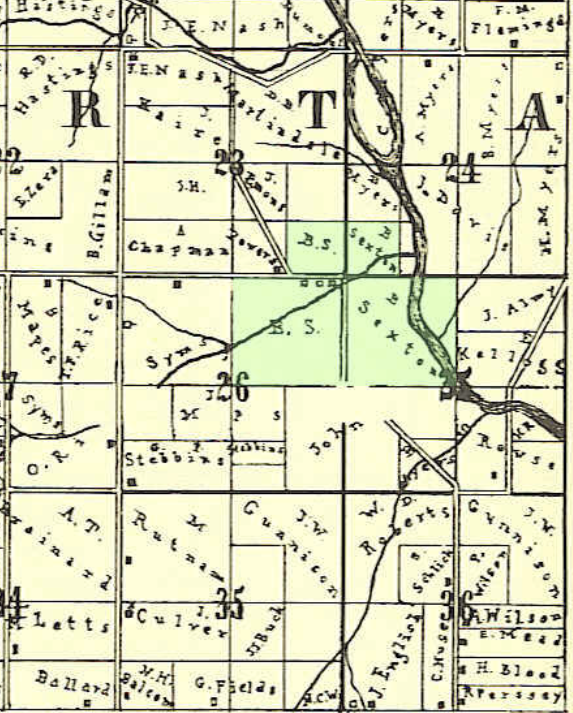
1855 Sparta Township map with Dr Bliss Sexton's property highlighted and future location of Sextonville.
Bliss soon re-established his medical practice and became the Sparta Township tax collector. He acquired two-and-a-half quarter sections at what is now the intersection of Twelve Mile Road and Alpine Avenue, where he made his home. In May of 1855, the doctor purchased 120 acres of land north of what is now 20 Mile Road between Sparta Avenue and Tyrone, at a time just prior to when the townships were separated.
Time moves slowly in Congress. Forty-five years after the start of the "War with Great Britain, declared by the United States on the 18th day of June, 1812," Washington DC approved a "Certificate of Allowance" for his expenses incurred during the war, which included: clothing items, blanket, a musket, bayonet, sword and belt, boots, and transportation. Charles Sexton appeared before L.S. Ballard, Justice of the Peace, on the 5th of November 1857, to certify his claim in the amount of $68.50. On the same day, the son, Isaiah B. Sexton, also filed his declaration for "Twenty one dollars". Charles died several months later.
As the 1860 Federal Census was enumerated at Sparta, Bliss gave his occupation as a "Botanist Physician". In addition to his career in the healing arts, Bliss played a key role in putting Sparta on the map, literally. The doctor envisioned the establishment of roads through the Northern Kent County wilderness; east to west from Muskegon to Cedar Springs, as well as north and south, from Englishville to Croton. During the 1860s, he organized people in favor of the proposal and successfully petitioned the state legislature to get the roadways built.
As Arzie Pinckney wrote in his I Remember column from a 1964 issue of The Sentinel-Leader, "The good Dr. Sexton got angry at some of the businessmen in Sparta and vowed that he would build a town that would take all the business away from Sparta and that the grass would grow on Sparta's Main Street." Exactly what led to the falling out, I cannot say. But Bliss did his best to make good on his threat.
Since he already owned about 400 acres at 12 Mile and Alpine, on both sides of the streets that abutted the Pere Marquette Railroad, he platted it out for development. "He built several small store buildings and houses on the north side of the road beginning at Alpine (where the Gerhardt Seelman and Gene Dancer residences were located in 1964). Some of the buildings were still standing until not too many years ago, but they were left to deteriorate and finally fell down while Sparta continued to do business as usual."
Arzie continued, "The Doctor had given his town a real name... Sextonville. He even had arrangements made with the railroad and they put Sextonville on their time table as a flag station. For a few pennies, you could flag the morning train coming north, to Sparta, do your trading, and catch the 10:30 AM train back home. Or you could flag the 10:30 AM train, go down to Grand Rapids and do your trading, catch the 6:00 PM train at Union Depot or Bridge St. Station and come back home. The railroad even built a small platform where you could wait for the trains."
-
From the Sentinel-Leader Letter-box:
When Eight Buildings Constituted Importance of Village
Editor, Sentinel-Leader:
"Life's fair illusions,
One by One without a trace
Have come and gone
Like vapors in the air.--Halse
I am not a student of psychology, but I have heard of it. It's a wonderful ology to hear its results explained by its advocates. I experienced a little of its working at one time, (verbally).
Take the road from Sparta southeast down through Sextonville. The doctor's little office with its window-full of bottles and dried herbs. "But meet Dr. Bliss Sexton." He is past the age for active work or visits. But he could pull teeth. He pulled one for me once. It doesn't quite express it to say extracted. He used that old inquisitorial instrument called turn-key on cant-hook power. There is not a fraction of doubt as to their efficiency. The tooth came and I looked up expecting to see the jaw bone with it. But long since then I have become satisfied that I lost none of my jaw bone. I believe that experience was even worse than listening to his lecture of treatment of diseases.
Seven or eight buildings and we are through the city. A large building on the northeast corner was occupied by O. Hoag as a hotel...
...Old Dr. B. Sexton, the good old homeopath, the founder of Sextonville, two miles away, but his ambition for a city never materialized."--H.M. Sleeper
On April 5, 1889, it was widely reported that "Lieut. Sexton served through the war of 1812, and had enrolled as his servant Bliss Sexton, his son. Bliss Sexton is now 84 years old, and a resident of Sparta, Kent county, and his name has just been placed on the pension rolls."--Alma Record
Dr. Sexton passed away at his home on November 20, 1897. His obituary stated Bliss was one of only twelve survivors and pensioners of the War of 1812 on the rolls in Washington, and he was the youngest. He lived an adventuresome life. He lived life with determination. He lived life well.
Contact
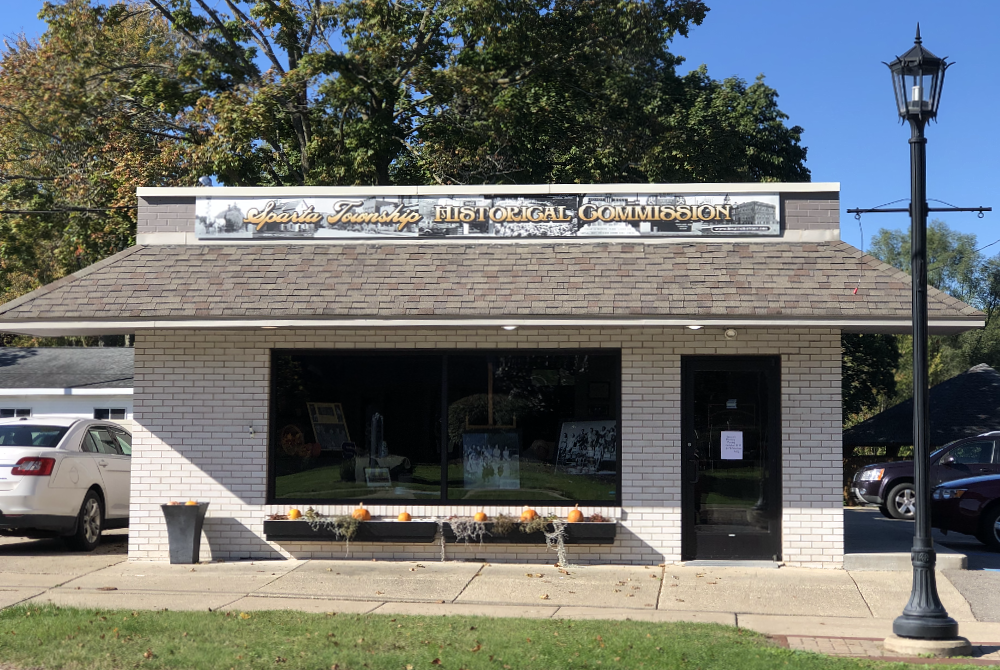
Sparta Township Historical Commission headquarters at 71 North Union Street
Our History Center is conveniently located at 71 North Union Street in downtown Sparta. Please join us for coffee and lively conversation on Monday mornings. Visits to the History Center can also be scheduled by appointment, for your convenience.
We do not receive mail at the History Center, instead, please use our mailing address, which is:
attn: Sparta Township Historical Commission
Sparta Township
160 E. Division St.
Sparta MI 49345
Our complete archives are now available online for your convenience. Just click STHC PastPerfect Catalog Access and begin your research!
For other inquiries, the Sparta Township Historical Commission can be reached by phone at: (616)606-0765 or via email at the following address:
